Serbia
Coordinates: 44°N 21°E / 44°N 21°E
| Republic of Serbia Република Србија Republika Srbija |
||||||
|---|---|---|---|---|---|---|
|
||||||
| Anthem: Боже правде/Bože pravde God of Justice |
||||||
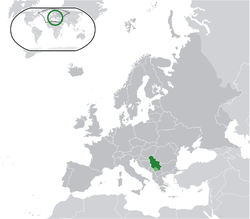 Location of Serbia (green) and the disputed territory of Kosovo (light green)
in Europe (dark grey). |
||||||
| Capital and largest city | Belgrade 44°48′N 20°28′E / 44.800°N 20.467°E | |||||
| Official languages | Serbian | |||||
| Ethnic groups (2011[1]) |
|
|||||
| Demonym | Serbian | |||||
| Government | Unitary parliamentary constitutional republic |
|||||
| • | President | Tomislav Nikolić | ||||
| • | Prime Minister | Aleksandar Vučić | ||||
| • | President of the National Assembly | Maja Gojković | ||||
| Legislature | National Assembly | |||||
| Formation | ||||||
| • | Medieval state | late 8th century | ||||
| • | Kingdom/Serbian Empire | 1217/1346 | ||||
| • | Fall of the Serbian Despotatea | 1459 (1537 de jure)[2] | ||||
| • | Principality of Serbia | 1815 | ||||
| • | De jure independence | 1878 | ||||
| • | Unification | 1912–18 | ||||
| • | Independent republic | 2006 | ||||
| Area | ||||||
| • | Including Kosovo | 88,361 km2 (113th) 34,116 sq mi |
||||
| • | Excluding Kosovo | 77,474 km2 (29,913 sq mi)[3] | ||||
| Population | ||||||
| • | 2016 estimate | 7,041,599 |
||||
| • | Density | 92.8/km2 (112th) 211/sq mi |
||||
| GDP (PPP) | 2016 estimate | |||||
| • | Total | $106.537 billion[5] (78th) | ||||
| • | Per capita | $14,938 (excluding Kosovo)[5] (83rd) | ||||
| GDP (nominal) | 2016 estimate | |||||
| • | Total | $39.541 billion[5] (86th) | ||||
| • | Per capita | $5,544 (excluding Kosovo)[5] (88th) | ||||
| Gini (2013) | 38[6] medium · 72nd |
|||||
| HDI (2014) | high · 66th |
|||||
| Currency | Serbian dinar (RSD) | |||||
| Time zone | CET (UTC+1) | |||||
| • | Summer (DST) | CEST (UTC+2) | ||||
| Drives on the | right | |||||
| Calling code | +381 | |||||
| ISO 3166 code | RS | |||||
| Internet TLD | ||||||
| a. | Belgrade, Mačva and Vojvodina were conquered by Ottomans between 1521–56 | |||||
Serbia (![]() i/ˈsɜːrbiə/, Serbian: Србија / Srbija, IPA: [sř̩bija]), officially the Republic of Serbia (Serbian: Република Србија / Republika Srbija), is a sovereign state situated at the crossroads of Central and Southeast Europe, covering the southern part of the Pannonian Plain and the central Balkans. Relative to its small territory, it is a diverse country distinguished by a transitional character, situated along cultural, geographic, climatic and other boundaries. Serbia is landlocked and borders Hungary to the north; Romania and Bulgaria to the east; Macedonia to the south; and Croatia, Bosnia-Herzegovina, and Montenegro to the southwest; it also claims a border with Albania through the disputed territory of Kosovo. Serbia numbers around 7 million residents,[4] and its capital, Belgrade, ranks among the largest cities in Southeast Europe.
i/ˈsɜːrbiə/, Serbian: Србија / Srbija, IPA: [sř̩bija]), officially the Republic of Serbia (Serbian: Република Србија / Republika Srbija), is a sovereign state situated at the crossroads of Central and Southeast Europe, covering the southern part of the Pannonian Plain and the central Balkans. Relative to its small territory, it is a diverse country distinguished by a transitional character, situated along cultural, geographic, climatic and other boundaries. Serbia is landlocked and borders Hungary to the north; Romania and Bulgaria to the east; Macedonia to the south; and Croatia, Bosnia-Herzegovina, and Montenegro to the southwest; it also claims a border with Albania through the disputed territory of Kosovo. Serbia numbers around 7 million residents,[4] and its capital, Belgrade, ranks among the largest cities in Southeast Europe.
Following the Slavic migrations to the Balkans from the 6th century onwards, Serbs established several states in the early Middle Ages. The Serbian Kingdom obtained recognition by Rome and the Byzantine Empire in 1217; it reached its peak in 1346 as a relatively short-lived Serbian Empire. By the mid-16th century, the entire modern-day Serbia was annexed by the Ottomans, at times interrupted by the Habsburg Empire, which started expanding towards Central Serbia since the end of the 17th century, while maintaining foothold in modern-day Vojvodina. In the early 19th century, the Serbian Revolution established the nation-state as the region's first constitutional monarchy, which subsequently expanded its territory.[8] Following disastrous casualties in World War I, and the subsequent unification of the Habsburg crownland of Vojvodina with Serbia, the country co-founded Yugoslavia with other South Slavic peoples, which would exist in various political formations until the Yugoslav Wars of the 1990s. As a result, Serbia formed a union with Montenegro in 1992, which broke apart in 2006, when Serbia again became an independent country. In 2008 the parliament of Kosovo, Serbia's southern province with an Albanian ethnic majority, declared independence, with mixed responses from the international community.
Serbia is a member of the UN, CoE, OSCE, PfP, BSEC, and CEFTA. An EU membership candidate since 2012,[9] Serbia has been negotiating its EU accession since January 2014, following the European Council and Commission endorsements in 2013.[10][11] The country is acceding to the WTO[12] and is a militarily neutral state. Serbia is an upper-middle income economy[13] with dominant service sector, followed by the industrial sector and agriculture. The country ranks high in Social Progress Index (45th)[14] as well as Global Peace Index (46th),[15] relatively high in Human Development Index (66th),[16] and is an economically moderately free country (77th).[17]
Geography
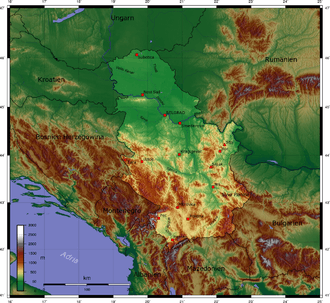
Located at the crossroads between Central[13][18][19] and Southern Europe, Serbia is found in the Balkan peninsula and the Pannonian Plain. Serbia lies between latitudes 41° and 47° N, and longitudes 18° and 23° E. The country covers a total of 88,361 km2 (including Kosovo), which places it at 113th place in the world; with Kosovo excluded, the total area is 77,474 km2,[3] which would make it 117th. Its total border length amounts to 2,027 km (Albania 115 km, Bosnia and Herzegovina 302 km, Bulgaria 318 km, Croatia 241 km, Hungary 151 km, Macedonia 221 km, Montenegro 203 km and Romania 476 km).[3] All of Kosovo's border with Albania (115 km), Macedonia (159 km) and Montenegro (79 km)[20] are under control of the Kosovo border police.[21] Serbia treats the 352 km long border between Kosovo and rest of Serbia as an "administrative line"; it is under shared control of Kosovo border police and Serbian police forces, and there are 11 crossing points.[22]
The Pannonian Plain covers the northern third of the country (Vojvodina and Mačva[23]) while the easternmost tip of Serbia extends into the Wallachian Plain. The terrain of central part of the country, with the region of Šumadija at its heart, consists chiefly of hills traversed by the rivers. Mountains dominate the southern third of Serbia. Dinaric Alps stretch in the west and the southwest following the flow of the rivers Drina and Ibar. Carpathian Mountains and Balkan Mountains stretch in north–south direction in the eastern Serbia.[24]
Ancient mountains in the southeast corner of the country belong to Rilo-Rhodope Mountain system. Elevation ranges from the Midžor peak of the Balkan Mountains at 2,169 metres (7,116 feet) (highest peak in Serbia, excluding Kosovo) to the lowest point of just 17 metres (56 feet) near the Danube river at Prahovo.[25] The largest lake is the Đerdap Lake (163 square kilometres or 63 square miles) and the longest river passing through Serbia the Danube (587.35 kilometres or 364.96 miles).
Climate
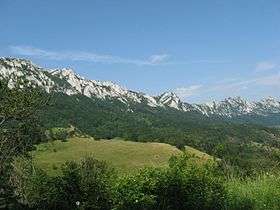
The climate of Serbia is under the influences of the landmass of Eurasia and Atlantic Ocean and Mediterranean Sea. With mean January temperatures around 0 °C (32 °F), and mean July temperatures of 22 °C (72 °F), it can be classified into warm-humid continental or humid subtropical climate.[26] In the north, the climate is more continental, with cold winters, and hot, humid summers along with well distributed rainfall patterns. In the south, summers and autumns are drier, and winters are relatively cold, with heavy inland snowfall in the mountains.
Differences in elevation, proximity to the Adriatic Sea and large river basins, as well as exposure to the winds account for climate variations.[27] Southern Serbia is subject to Mediterranean influences.[28] However, the Dinaric Alps and other mountain ranges contribute to the cooling of most of the warm air masses. Winters are quite harsh in the Pešter plateau, because of the mountains which encircle it.[29] One of the climatic features of Serbia is Košava, a cold and very squally southeastern wind which starts in the Carpathian Mountains and follows the Danube northwest through the Iron Gate where it gains a jet effect and continues to Belgrade and can spread as far south as Niš.[30]

The average annual air temperature for the period 1961–1990 for the area with an altitude of up to 300 m (984 ft) is 10.9 °C (51.6 °F). The areas with an altitude of 300 to 500 m (984 to 1,640 ft) have an average annual temperature of around 10.0 °C (50.0 °F), and over 1,000 m (3,281 ft) of altitude around 6.0 °C (42.8 °F).[31] The lowest recorded temperature in Serbia was −39.5 °C (−39.1 °F) on 13 January 1985, Karajukića Bunari in Pešter, and the highest was 44.9 °C or 112.8 °F, on 24 July 2007, recorded in Smederevska Palanka.[32]
Serbia is one of few European countries with very high risk exposure to the natural hazards (earthquakes, storms, floods, droughts).[33] It is estimated that potential floods, particularly in areas of Central Serbia, threaten over 500 larger settlements and an area of 16,000 square kilometers.[34] The most disastrous were the floods in May 2014, when 57 people died and a damage of over a 1.5 billion euro was incited.[35]
Hydrology
Almost all of Serbia's rivers drain to the Black Sea, by way of the Danube river. The Danube, the second largest European river, passes through Serbia with 588 kilometers (21% of its overall length) and represents the largest source of fresh water. It is joined by its biggest tributaries, the Great Morava (longest river entirely in Serbia with 493 km of length), Sava and Tisza rivers.[36] One notable exception is the Pčinja which flows into the Aegean.
Due to configuration of the terrain, natural lakes are sparse and small; most of them are located in the lowlands of Vojvodina, like the aeolian lake Palić or numerous oxbow lakes along river flows (like Zasavica and Carska Bara). However, there are numerous artificial lakes, mostly due to hydroelectric dams, the biggest being Đerdap (Iron Gates) on the Danube with 163 km2 on the Serbian side (a total area of 253 km2 is shared with Romania) as well as the deepest (with maximum depth of 92 m); Perućac on the Drina, and Vlasina. The largest waterfall, Jelovarnik, located in Kopaonik, is 71 m high.[37] Abundance of relatively unpolluted surface waters and numerous underground natural and mineral water sources of high water quality presents a chance for export and economy improvement; however, more extensive exploitation and production of bottled water began only recently.
Environment
With 29.1% of its territory covered by forest, Serbia is considered to be a middle-forested country, compared on a global scale to world forest coverage at 30%, and European average of 35%. The total forest area in Serbia is 2,252,000 hа (1,194,000 hа or 53% are state-owned, and 1,058,387 hа or 47% are privately owned) or 0.3 ha per inhabitant.[38] The most common trees are oak, beech, pines and firs.
Serbia is a country of rich ecosystem and species diversity – covering only 1.9% of the whole European territory Serbia is home to 39% of European vascular flora, 51% of European fish fauna, 40% of European reptile and amphibian fauna, 74% of European bird fauna, 67% European mammal fauna.[39] Its abundance of mountains and rivers make it an ideal environment for a variety of animals, many of which are protected including wolves, lynx, bears, foxes and stags.
Mountain of Tara in western Serbia is one of the last regions in Europe where bears can still live in absolute freedom.[40] Serbia is also home to about 380 species of bird. In Carska Bara, there are over 300 bird species on just a few square kilometers.[41] Uvac Gorge is considered one of the last habitats of the griffon vulture in Europe.[42]
There are 377 protected areas of Serbia, encompassing 4,947 square kilometers or 6.4% of the country. The "Spatial plan of the Republic of Serbia" states that the total protected area should be increased to 12% by 2021.[39] Those protected areas include 5 national parks (Đerdap, Tara, Kopaonik, Fruška Gora and Šar Mountain), 15 nature parks, 15 "landscapes of outstanding features", 61 nature reserves, and 281 natural monuments.[37]
Air pollution is a significant problem in Bor area, due to work of large copper mining and smelting complex, and Pančevo where oil and petrochemical industry is based.[43] Some cities suffer from water supply problems, due to mismanagement and low investments in the past, as well as water pollution (like the pollution of the Ibar River from the Trepča zinc-lead combinate, affecting the city of Kraljevo, or the presence of natural arsenic in underground waters in Zrenjanin).
Poor waste management has been identified as one of the most important environmental problems in Serbia and the recycling is a fledgling activity, with only 15% of its waste being turned back for reuse.[44] The 1999 NATO bombing caused serious damage to the environment, with several thousand tons of toxic chemicals stored in targeted factories and refineries released into the soil and water basins.
History
Prehistory
Archeological evidence of Paleolithic settlements on the territory of present-day Serbia are scarce. A fragment of a human jaw, was found in Sićevo (Mala Balanica) and believed to be up to 525,000—397,000 years old.[45]
Approximately around 6,500 years BC, during the Neolithic, the Starčevo, and Vinča cultures existed in or near modern-day Belgrade and dominated much of the Southeastern Europe, (as well as parts of Central Europe and Asia Minor).[46][47] Two important local archeological sites from this era, Lepenski Vir and Vinča-Belo Brdo, still exist near the banks of the Danube.
Ancient history
During the Iron Age, Thracians, Dacians, and Illyrians were encountered by the Ancient Greeks during their expansion into the south of modern Serbia in the 4th century BC; the northwesternmost point of Alexander the Great's empire being the town of Kale-Krševica.[48] The Greek influx was followed shortly after by the Celtic tribe of Scordisci, who settled throughout the area in the 3rd century BC. The Scordisci formed their own tribal state in this area, and built several fortifications, including their state capital at Singidunum (present-day Belgrade) and Naissos (present-day Niš).
The Romans conquered much of the territory in the 2nd century BC. In 167 BC the Roman province of Illyricum was established; the remainder was conquered around 75 BC, forming the Roman province of Moesia Superior; the modern-day Srem region was conquered in 9 BC; and Bačka and Banat in 106 AD after the Dacian wars. As a result of this, contemporary Serbia extends fully or partially over several former Roman provinces, including Moesia, Pannonia, Praevalitana, Dalmatia, Dacia and Macedonia.
The chief towns of Upper Moesia (and wider) were: Singidunum (Belgrade), Viminacium (now Old Kostolac), Remesiana (now Bela Palanka), Naissos (Niš), and Sirmium (now Sremska Mitrovica), the latter of which served as a Roman capital during the Tetrarchy.[49] Seventeen Roman Emperors were born in the area of modern-day Serbia, second only to contemporary Italy.[50] The most famous of these was Constantine the Great, the first Christian Emperor, who issued an edict ordering religious tolerance throughout the Empire.
When the Roman Empire was divided in 395, most of Serbia remained under the Eastern Roman Empire, while its western parts were included in the Western Roman Empire. By the early 6th century, Southern Slavs were present throughout the Byzantine Empire in large numbers.[51]
Middle Ages

The Serbs in the Byzantine world lived in the so-called Slav lands, lands initially out of Byzantine control and independent.[52] The Vlastimirović dynasty established the Serbian Principality in the 8th century. In 822, the Serbs "inhabited the greater part of Dalmatia",[53] and Christianity was adopted as the state religion in c. 870.[54] In the mid-10th century the state had emerged into a tribal confederation that stretched to the shores of the Adriatic Sea by the Neretva, the Sava, the Morava, and Skadar.[55]
The state disintegrated after the death of the last known Vlastimirid ruler; the Byzantines annexed the region and held it for a century, until 1040 when the Serbs under the leadership of what would become the Vojislavljević dynasty revolted in Duklja, a maritime region.[56] In 1091, the Vukanović dynasty established the Serbian Grand Principality, based in Raška (Rascia).[56] The two-halves were reunited in 1142.[57]
In 1166, Stefan Nemanja assumed the throne, marking the beginning of a prospering Serbia, henceforth under the rule of the Nemanjić dynasty.[58] Nemanja's son Rastko (posth. Saint Sava), gained autocephaly for the Serbian Church in 1217 and authored the oldest known constitution, and at the same time Stefan the First-Crowned established the Serbian Kingdom.[59] Medieval Serbia reached its peak during the reign of Stefan Dušan, who took advantage of the Byzantine civil war and doubled the size of the state by conquering territories to the south and east at the expense of Byzantium, reaching as far as the Peloponnese, also being crowned Emperor of Serbs and Greeks along the way.
The Battle of Kosovo against the rising Ottoman Empire in 1389 marks a turning point and is considered as a beginning of the fall of the medieval Serbian state. The magnate families Lazarević and Branković ruled the suzerain Serbian Despotate afterwards (in the 15th and 16th centuries). After the fall of Constantinople to the Ottomans in 1453 and the Siege of Belgrade, the Serbian Despotate fell in 1459 following the siege of the provisional capital of Smederevo. By 1455, central Serbia was completely conquered by the Ottoman Empire.[60] After repelling Ottoman attacks for over 70 years, Belgrade finally fell in 1521, opening the way for Ottoman expansion into Central Europe. Vojvodina, as a part of Habsburg Empire, resisted Ottoman rule until well into the 16th century.
Ottoman and Habsburg rule
After the loss of independence to the Kingdom of Hungary and the Ottoman Empire, Serbia briefly regained sovereignty under Jovan Nenad in the 16th century. Three Habsburg invasions and numerous rebellions constantly challenged Ottoman rule. One famous incident was the Banat Uprising in 1595, which was part of the Long War between the Ottomans and the Habsburgs.[61] The area of modern Vojvodina endured a century-long Ottoman occupation before being ceded to the Habsburg Empire at the end of the 17th century under the Treaty of Karlowitz.

In all Serb lands south of the rivers Danube and Sava, the nobility was eliminated and the peasantry was enserfed to Ottoman masters, while much of the clergy fled or were confined to the isolated monasteries. Under the Ottoman system, Serbs, as Christians, were considered an inferior class of people and subjected to heavy taxes, and a small portion of the Serbian populace experienced Islamisation. The Ottomans abolished the Serbian Patriarchate (1463), but reestablished it in 1557, providing for limited continuation of Serbian cultural traditions within the empire.[62][63]
As the Great Serb Migrations depopulated most of southern Serbia, the Serbs sought refuge across the Danube River in Vojvodina to the north and the Military Frontier in the west, where they were granted rights by the Austrian crown under measures such as the Statuta Wallachorum of 1630. The ecclesiastical center of the Serbs also moved northwards, to the Metropolitanate of Sremski Karlovci, as the Serbian Patriarchate was once-again abolished by the Ottomans in 1766.[64] Following several petitions, the Holy Roman Emperor Leopold I formally granted Serbs who wished to leave the right to their autonomous crownland.[65]
In 1718–39, the Habsburg Monarchy occupied Central Serbia and established the "Kingdom of Serbia". Apart from Vojvodina and Northern Belgrade which were absorbed into the Habsburg Empire, Central Serbia was occupied by the Habsburgs again in in 1686–91 and in 1788–92.
Revolution and independence
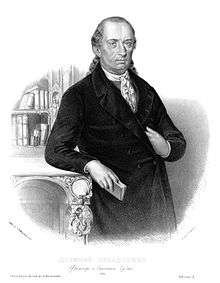

Right: Beginning of the Second Serbian Uprising in Takovo, the second phase of the Serbian Revolution
The Serbian Revolution for independence from the Ottoman Empire lasted eleven years, from 1804 until 1815.[66] The revolution comprised two separate uprisings which gained autonomy from the Ottoman Empire that eventually evolved towards full independence (1835–1867).[67][68] During the First Serbian Uprising, led by Duke Karađorđe Petrović, Serbia was independent for almost a decade before the Ottoman army was able to reoccupy the country. Shortly after this, the Second Serbian Uprising began. Led by Miloš Obrenović, it ended in 1815 with a compromise between Serbian revolutionaries and Ottoman authorities.[69] Likewise, Serbia was one of the first nations in the Balkans to abolish feudalism.[70] The Convention of Ackerman in 1826, the Treaty of Adrianople in 1829 and finally, the Hatt-i Sharif, recognized the suzerainty of Serbia. The first Serbian Constitution was adopted on 15 February 1835.[71][72]
Following the clashes between the Ottoman army and Serbs in Belgrade in 1862, and under pressure from the Great Powers, by 1867 the last Turkish soldiers left the Principality, making the country de facto independent. By enacting a new constitution without consulting the Porte, Serbian diplomats confirmed the de facto independence of the country. In 1876, Serbia declared war on the Ottoman Empire, proclaiming its unification with Bosnia.
The formal independence of the country was internationally recognized at the Congress of Berlin in 1878, which formally ended the Russo-Turkish War; this treaty, however, prohibited Serbia from uniting with Bosnia by placing the latter under Austro-Hungarian occupation, alongside the occupation of Sanjak of Novi Pazar.[73] From 1815 to 1903, the Principality of Serbia was ruled by the House of Obrenović, save for the rule of Prince Aleksandar Karađorđević between 1842 and 1858. In 1882, Serbia became a Kingdom, ruled by King Milan I. The House of Karađorđević, descendants of the revolutionary leader Karađorđe Petrović, assumed power in 1903 following the May Overthrow. In the north, the 1848 revolution in Austria led to the establishment of the autonomous territory of Serbian Vojvodina; by 1849, the region was transformed into the Voivodeship of Serbia and Banat of Temeschwar.
Balkan Wars, World War I and the First Yugoslavia
In the course of the First Balkan War in 1912, the Balkan League defeated the Ottoman Empire and captured its European territories, which enabled territorial expansion into Raška and Kosovo. The Second Balkan War soon ensued when Bulgaria turned on its former allies, but was defeated, resulting in the Treaty of Bucharest. In two years, Serbia enlarged its territory by 80% and its population by 50%;[74] it also suffered high casualties on the eve of World War I, with around 20,000 dead.[75] Austria-Hungary became wary of the rising regional power on its borders and its potential to become an anchor for unification of all South Slavs, and the relationship between the two countries became tense.
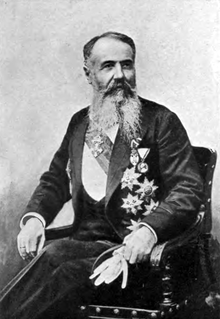
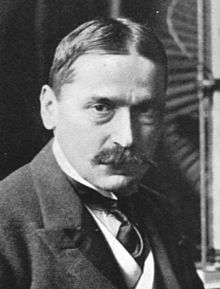
Right: Mihajlo Pupin, physicist and physical chemist, a founding member of NACA. He influenced the final decisions of the Paris Peace Conference when the borders of the Kingdom were drawn
The assassination of Archduke Franz Ferdinand of Austria on 28 June 1914 in Sarajevo by Gavrilo Princip, a member of the Young Bosnia organization, led to Austria-Hungary declaring war on Serbia.[76] In defense of its ally Serbia, Russia mobilized its troops, which resulted in Austria-Hungary's ally Germany declaring war on Russia. The retaliation by Austria-Hungary against Serbia activated a series of military alliances that set off a chain reaction of war declarations across the continent, leading to the outbreak of World War I within a month.[77] Serbia won the first major battles of World War I, including the Battle of Cer and Battle of Kolubara – marking the first Allied victories against the Central Powers in World War I.[78]
Despite initial success, it was eventually overpowered by the Central Powers in 1915. Most of its army and some people retreated into exile to Greece and Corfu, where they recovered, regrouped and returned to the Macedonian front to lead a final breakthrough through enemy lines on 15 September 1918, liberating Serbia and defeating the Austro-Hungarian Empire and Bulgaria.[79] Serbia, with its campaign, was a major Balkan Entente Power[80] which contributed significantly to the Allied victory in the Balkans in November 1918, especially by helping France force Bulgaria's capitulation.[81] Serbia was classified as a minor Entente power.[82]
Serbia's casualties accounted for 8% of the total Entente military deaths; 58% (243,600) soldiers of the Serbian army perished in the war.[83] The total number of casualties is placed around 700,000,[84] more than 16% of Serbia's prewar size,[77] and a majority (57%) of its overall male population.[85][86][87] As the Austro-Hungarian Empire collapsed, the territory of Syrmia united with Serbia on 24 November 1918, followed by Banat, Bačka and Baranja a day later, thereby bringing the entire Vojvodina into the Serb Kingdom. On 26 November 1918, the Podgorica Assembly deposed the House of Petrović-Njegoš and united Montenegro with Serbia. On 1 December 1918, Serbian Prince Regent Alexander of Serbia proclaimed the Kingdom of the Serbs, Croats, and Slovenes under King Peter I of Serbia.

King Peter was succeeded by his son, Alexander, in August 1921. Serb centralists and Croat autonomists clashed in the parliament, and most governments were fragile and short-lived. Nikola Pašić, a conservative prime minister, headed or dominated most governments until his death. King Alexander changed the name of the country to Yugoslavia and changed the internal divisions from the 33 oblasts to nine new banovinas. The effect of Alexander's dictatorship was to further alienate the non-Serbs from the idea of unity.[88]
Alexander was assassinated in Marseille, during an official visit in 1934 by Vlado Chernozemski, member of the IMRO. Alexander was succeeded by his eleven-year-old son Peter II and a regency council was headed by his cousin, Prince Paul. In August 1939 the Cvetković–Maček Agreement established an autonomous Banate of Croatia as a solution to Croatian concerns.
World War II and the Second Yugoslavia
In 1941, in spite of Yugoslav attempts to remain neutral in the war, the Axis powers invaded Yugoslavia. The territory of modern Serbia was divided between Hungary, Bulgaria, Independent State of Croatia and Italy (greater Albania and Montenegro), while the remaining part of Serbia was placed under German Military administration, with Serbian puppet governments led by Milan Aćimović and Milan Nedić. The occupied territory was the scene of a civil war between royalist Chetniks commanded by Draža Mihailović and communist partisans commanded by Josip Broz Tito. Against these forces were arrayed Axis auxiliary units of the Serbian Volunteer Corps and the Serbian State Guard. Draginac and Loznica massacre of 2,950 villagers in Western Serbia in 1941 was the first large execution of civilians in occupied Serbia by Germans, with Kragujevac massacre and Novi Sad Raid of Jews and Serbs by Hungarian fascists being the most notorious, with over 3,000 victims in each case.[89][90][91] After one year of occupation, around 16,000 Serbian Jews were murdered in the area, or around 90% of its pre-war Jewish population. Many concentration camps were established across the area. Banjica concentration camp was the largest concentration camp, with primary victims being Serbian Jews, Roma, and Serb political prisoners.[92]

The Axis puppet state of the Independent State of Croatia committed large-scale persecution and genocide of Serbs, Jews, and Roma.[93] The estimate of the United States Holocaust Memorial Museum indicates that between 320,000 and 340,000 ethnic Serb residents of Croatia, Bosnia and northern Serbia were murdered during the Ustaše genocide campaign;[94] the same figures are supported by the Jewish Virtual Library.[95] Official Yugoslav sources used to estimate more than 700,000 victims, mostly Serbs.[96] The Jasenovac memorial so far lists 82,085 names killed at the this concentration camp alone,[97] out of around 100,000 estimated victims (75% of whom were of Serbian origin).[98] Out of roughly 1 million casualties in all of Yugoslavia up until 1944,[99][100] around 250,000 were citizens of Serbia of different ethnicities.[101]
The Republic of Užice was a short-lived liberated territory established by the Partisans and the first liberated territory in World War II Europe, organized as a military mini-state that existed in the autumn of 1941 in the west of occupied Serbia. By late 1944, the Belgrade Offensive swung in favour of the partisans in the civil war; the partisans subsequently gained control of Yugoslavia.[102] Following the Belgrade Offensive, the Syrmian Front was the last major military action of World War II in Serbia.
The victory of the Communist Partisans resulted in the abolition of the monarchy and a subsequent constitutional referendum. A one-party state was soon established in Yugoslavia by the League of Communists of Yugoslavia, between 60,000 and 70,000 people were killed in Serbia during the communist takeover.[103] All opposition was suppressed and people deemed to be promoting opposition to socialism or promoting separatism were imprisoned or executed for sedition. Serbia became a constituent republic within the SFRY known as the Socialist Republic of Serbia, and had a republic-branch of the federal communist party, the League of Communists of Serbia.

Serbia's most powerful and influential politician in Tito-era Yugoslavia was Aleksandar Ranković, one of the "big four" Yugoslav leaders, alongside Tito, Edvard Kardelj, and Milovan Đilas.[104] Ranković was later removed from the office because of the disagreements regarding Kosovo's nomenklatura and the unity of Serbia.[104] Ranković's dismissal was highly unpopular amongst Serbs.[105] Pro-decentralization reformers in Yugoslavia succeeded in the late 1960s in attaining substantial decentralization of powers, creating substantial autonomy in Kosovo and Vojvodina, and recognizing a Yugoslav Muslim nationality.[105] As a result of these reforms, there was a massive overhaul of Kosovo's nomenklatura and police, that shifted from being Serb-dominated to ethnic Albanian-dominated through firing Serbs on a large scale.[105] Further concessions were made to the ethnic Albanians of Kosovo in response to unrest, including the creation of the University of Pristina as an Albanian language institution.[105] These changes created widespread fear amongst Serbs of being treated as second-class citizens.[106]
Breakup of Yugoslavia and political transition
In 1989, Slobodan Milošević rose to power in Serbia. Milošević promised a reduction of powers for the autonomous provinces of Kosovo and Vojvodina, where his allies subsequently took over power, during the Anti-bureaucratic revolution.[107] This ignited tensions with the communist leadership of the other republics, and awoke nationalism across the country that eventually resulted in the Breakup of Yugoslavia, with Slovenia, Croatia, Bosnia and Herzegovina, Macedonia and Kosovo declaring independence.[108] Serbia and Montenegro remained together as the Federal Republic of Yugoslavia (FRY).
Fueled by ethnic tensions, the Yugoslav Wars erupted, with the most severe conflicts taking place in Croatia and Bosnia, where ethnic Serb populations opposed independence from Yugoslavia. The FRY remained outside the conflicts, but provided logistic, military and financial support to Serb forces in Croatia and Bosnia and Herzegovina. In response, the UN imposed sanctions against the Federal Republic of Yugoslavia in May 1992,[109] which led to political isolation and the collapse of the economy.
Multiparty democracy was introduced in Serbia in 1990, officially dismantling the one-party system. Critics of Milošević claimed that the government continued to be authoritarian despite constitutional changes, as Milošević maintained strong political influence over the state media and security apparatus.[110][111] When the ruling Socialist Party of Serbia refused to accept its defeat in municipal elections in 1996, Serbians engaged in large protests against the government.

Between 1998 and 1999, peace was broken again, when the situation in Kosovo worsened with continued clashes between Yugoslav security forces and the Albanian guerilla Kosovo Liberation Army. The confrontations led to the short Kosovo War, which ended in withdrawal of Serbian forces from Kosovo and the establishment of UN administration of the province.[112] After presidential elections in September 2000, opposition parties accused Milošević of electoral fraud. A campaign of civil resistance followed, led by the Democratic Opposition of Serbia (DOS), a broad coalition of anti-Milošević parties. This culminated on 5 October when half a million people from all over the country congregated in Belgrade, compelling Milošević to concede defeat.[113] The fall of Milošević ended Yugoslavia's international isolation. Milošević was sent to the International Criminal Tribunal for the former Yugoslavia. The DOS announced that FR Yugoslavia would seek to join the European Union. In 2003, the Federal Republic of Yugoslavia was renamed Serbia and Montenegro; the EU opened negotiations with the country for the Stabilization and Association Agreement. Serbia's political climate remained tense and in 2003, the prime minister Zoran Đinđić was assassinated as result of a plot originating from circles of organized crime and former security officials.
On 21 May 2006, Montenegro held a referendum to determine whether to end its union with Serbia. The results showed 55.4% of voters in favor of independence, which was just above the 55% required by the referendum. On 5 June 2006, the National Assembly of Serbia declared Serbia to be the legal successor to the former state union.[114] The province of Kosovo unilaterally declared independence from Serbia on 17 February 2008. Serbia immediately condemned the declaration and continues to deny any statehood to Kosovo. The declaration has sparked varied responses from the international community, some welcoming it, while others condemned the unilateral move.[115] Status neutral talks between Serbia and Kosovo-Albanian authorities are held in Brussels, mediated by the EU.
In April 2008 Serbia was invited to join the Intensified Dialogue programme with NATO despite the diplomatic rift with the alliance over Kosovo.[116] Serbia officially applied for membership in the European Union on 22 December 2009,[117] and received candidate status on 1 March 2012, following a delay in December 2011.[9][118] Following a positive recommendation of the European Commission and European Council in June 2013, negotiations to join the EU commenced in January 2014.[119]
Politics
Serbia is a parliamentary republic, with the government divided into legislative, executive and judiciary branches.
Serbia had one of the first modern constitutions in Europe, the 1835 Constitution (known as "Sretenje Constitution"), which was at the time considered among the most progressive and liberal constitutions in the world. Since then it has adopted 10 different constitutions.[120] The current constitution was adopted on 8 November 2006 in the aftermath of Montenegro independence referendum which by consequence renewed the independence of Serbia itself.[121] The Constitutional Court rules on matters regarding the Constitution.
The President of the Republic (Predsednik Republike) is the head of state, is elected by popular vote to a five-year term and is limited by the Constitution to a maximum of two terms. In addition to being the commander in chief of the armed forces, the president has the procedural duty of appointing the prime minister with the consent of the parliament, and has some influence on foreign policy.[122] Tomislav Nikolić is the current president following the 2012 presidential election.[123] Seat of the presidency is Novi Dvor.
The Government (Vlada) is composed of the prime minister and cabinet ministers. The Government is responsible for proposing legislation and a budget, executing the laws, and guiding the foreign and internal policies. The current prime minister is Aleksandar Vučić of the Serbian Progressive Party.[124]
The National Assembly (Narodna skupština) is a unicameral legislative body. The National Assembly has the power to enact laws, approve the budget, schedule presidential elections, select and dismiss the Prime Minister and other ministers, declare war, and ratify international treaties and agreements.[125] It is composed of 250 proportionally elected members who serve four-year terms. The largest political parties in Serbia are the centre-right Serbian Progressive Party, leftist Socialist Party of Serbia and centre-left Democratic Party.[126]
Law and criminal justice
Serbia has a three-tiered judicial system, made up of the Supreme Court of Cassation as the court of the last resort, Courts of Appeal as the appellate instance, and Basic and High courts as the general jurisdictions at first instance. The Supreme Court of Cassation, the highest court in the Republic of Serbia, began to operate on 1 January 2010 in accordance with the provisions of the new Law on Organization of Courts. With the amendments and supplements to the Law on Organization of Courts and the new Law on Seats and Territories of the Courts and Public Prosecutors Offices, a new network of courts was launched at the beginning of 2014.[127]
Courts of special jurisdictions are the Administrative Court, commercial courts (including the Commercial Court of Appeal at second instance) and misdemeanour courts (including High Misdemeanor Court at second instance).[128] The judiciary is overseen by the Ministry of Justice. Serbia has a typical civil law legal system.
Law enforcement is the responsibility of the Serbian Police, which is subordinate to the Ministry of the Interior. Serbian Police fields 26,527 uniformed officers.[129] National security and counterintelligence are the responsibility of the Security Information Agency (BIA).[130]
Foreign relations
Serbia has established diplomatic relations with 188 UN member states, the Holy See, the Sovereign Military Order of Malta, and the European Union.[131] Foreign relations are conducted through the Ministry of Foreign Affairs. Serbia has a network of 65 embassies and 23 consulates internationally.[132] There are 65 foreign embassies, 5 consulates and 4 liaison offices in Serbia.[133]
Serbian foreign policy is focused on achieving the strategic goal of becoming a member state of the European Union (EU). Serbia started the process of joining the EU by signing of the Stabilisation and Association Agreement on 29 April 2008 and officially applied for membership in the European Union on 22 December 2009.[134] It received a full candidate status on 1 March 2012 and started accession talks on 21 January 2014.[10][135]
The province of Kosovo declared independence from Serbia on 17 February 2008, which sparked varied responses from the international community, some welcoming it, while others condemn the unilateral move.[115] Serbia has, at first, recalled its ambassadors from states which have recognized Kosovo, in protest.[136]
Military
The Serbian Armed Forces are subordinate to the Ministry of Defence, and are composed of the Army and the Air Force. Although a landlocked country, Serbia operates a River Flotilla which patrols on the Danube, Sava, and Tisza rivers. The Serbian Chief of the General Staff reports to the Defence Minister. The Chief of Staff is appointed by the President, who is the Commander-in-chief.[122] As of 2012, Serbia defence budget amounts to $612 million or an estimated 1.6% of the country's GDP.[137]
 Serbian Air Force and Air Defence |
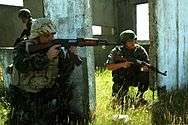 Serbian Armed Forces |
Traditionally having relied on a large number of conscripts, Serbian Armed Forces went through a period of downsizing, restructuring and professionalisation. Conscription was abolished on 1 January 2011.[138] Serbian Armed Forces have 28,000 active troops,[139] supplemented by the "active reserve" which numbers 20,000 members and "passive reserve" with about 170,000.[140][141]
Serbia participates in the NATO Individual Partnership Action Plan program,[142] but has shown no intention of joining NATO in the near future, due to significant popular rejection, largely derived from the NATO bombing of Yugoslavia in 1999.[143] It is an observer member of the Collective Securities Treaty Organization (CSTO)[144] The country also signed the Stability Pact for South Eastern Europe. The Serbian Armed Forces take part in several multinational peacekeeping missions, including deployments in Lebanon, Cyprus, Ivory Coast, and Liberia.[145]
Serbia is a large producer and exporter of military equipment in the region. Defence exports totaled around $250 million in 2011.[137] Serbia exports across the world, notably to the Middle East, Africa, Southeast Asia, and North America.[146] The defence industry has seen significant growth over the years and it continues to grow on a yearly basis.[147][148]
Administrative divisions
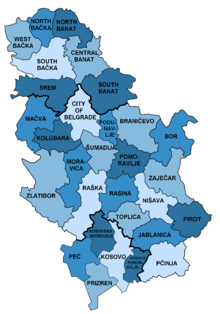
Serbia is a unitary state[149] composed of municipalities/cities, districts, and two autonomous provinces. In Serbia, excluding Kosovo, there are 138 municipalities (opštine) and 23 cities (gradovi), which form the basic units of local self-government.[150] Apart from municipalities, there are 24 districts (okruzi), with the City of Belgrade constituting an additional district. Except for Belgrade, which has an elected local government, districts are regional centers of state authority, but have no powers of their own; they present purely administrative divisions.[150]
Serbia has two autonomous provinces, Vojvodina in the north, and Kosovo and Metohija in the south,[150] while the remaining area, "Central Serbia", never had its own regional authority. Following the Kosovo War, UN peacekeepers entered Kosovo, as per UNSC Resolution 1244. In 2008, Kosovo declared independence.[151] The government of Serbia did not recognize the declaration, considering it illegal and illegitimate.[152]
Demographics
As of 2011 census, Serbia (excluding Kosovo) has a total population of 7,186,862 and the overall population density is medium as it stands at 92.8 inhabitants per square kilometer.[153] The census was not conducted in Kosovo which held its own census that numbered their total population at 1,739,825,[154] excluding Serb-inhabited North Kosovo, as Serbs from that area (about 50,000) boycotted the census.
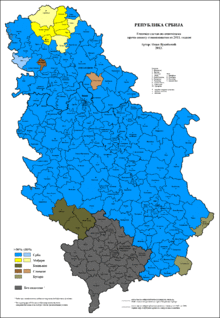
Serbia has been enduring a demographic crisis since the beginning of the 1990s, with a death rate that has continuously exceeded its birth rate, and a total fertility rate of 1.44 children per mother, one of the lowest in the world.[155] Serbia subsequently has one of the oldest populations in the world, with the average age of 42.2 years,[156] and its population is shrinking at one of the fastest rates in the world.[157] A fifth of all households consist of only one person, and just one-fourth of four and more persons.[158] Average Life expectancy in Serbia at birth is 74.2 years.[159]
During the 1990s, Serbia used to have the largest refugee population in Europe.[160] Refugees and internally displaced persons (IDPs) in Serbia formed between 7% and 7.5% of its population – about half a million refugees sought refuge in the country following the series of Yugoslav wars, mainly from Croatia (and to a lesser extent from Bosnia and Herzegovina) and the IDPs from Kosovo.[161] Meanwhile, it is estimated that 300,000 people left Serbia during the 1990s, 20% of which had a higher education.[162][163]
Serbs with 5,988,150 are the largest ethnic group in Serbia, representing 83% of the total population (excluding Kosovo). With a population of 253,899, Hungarians are the largest ethnic minority in Serbia, concentrated predominately in northern Vojvodina and representing 3.5% of the country's population (13% in Vojvodina). Romani population stands at 147,604 according to the 2011 census but unofficial estimates place their actual number between 400,000 and 500,000.[164] Bosniaks with 145,278 are concentrated in Raška (Sandžak), in the southwest. Other minority groups include Croats, Slovaks, Albanians, Montenegrins, Vlachs, Romanians, Macedonians and Bulgarians. Chinese, estimated at about 15,000, are the only significant immigrant minority.[165][166] Vojvodina has a multi-ethnic and multi-cultural identity;[167][168] there are more than 26 ethnic groups in the province,[169] which has six official languages.[170]
The majority of the population, or 59.4%, reside in urban areas and some 16.1% in Belgrade alone. Belgrade is the only city with more than a million inhabitants and there are four more with over 100,000 inhabitants.[171]
| | |||||||||
|---|---|---|---|---|---|---|---|---|---|
| Rank | Name | District | Pop. | Rank | Name | District | Pop. | ||
 Belgrade  Novi Sad |
1 | Belgrade | Belgrade | 1,233,796 | 11 | Smederevo | Smederevo | 64,175 | Niš  Kragujevac |
| 2 | Novi Sad | Novi Sad | 277,522 | 12 | Leskovac | Leskovac | 60,288 | ||
| 3 | Niš | Niš | 187,544 | 13 | Valjevo | Valjevo | 58,932 | ||
| 4 | Kragujevac | Kragujevac | 150,835 | 14 | Kruševac | Kruševac | 58,745 | ||
| 5 | Subotica | Subotica | 105,681 | 15 | Vranje | Vranje | 55,138 | ||
| 6 | Zrenjanin | Zrenjanin | 76,511 | 16 | Šabac | Šabac | 53,919 | ||
| 7 | Pančevo | Pančevo | 76,203 | 17 | Užice | Užice | 52,646 | ||
| 8 | Čačak | Čačak | 73,331 | 18 | Sombor | Sombor | 47,623 | ||
| 9 | Novi Pazar | Novi Pazar | 66,527 | 19 | Požarevac | Požarevac | 44,183 | ||
| 10 | Kraljevo | Kraljevo | 64,175 | 20 | Pirot | Pirot | 38,785 | ||
Religion
The Constitution of Serbia defines it as a secular state with guaranteed religious freedom. Orthodox Christians with 6,079,396 comprise 84.5% of country's population. The Serbian Orthodox Church is the largest and traditional church of the country, adherents of which are overwhelmingly Serbs. Other Orthodox Christian communities in Serbia include Montenegrins, Romanians, Vlachs, Macedonians and Bulgarians.

Roman Catholics number 356,957 in Serbia, or roughly 6% of the population, mostly in Vojvodina (especially its northern part) which is home to minority ethnic groups such as Hungarians, Croats, Bunjevci, as well as to some Slovaks and Czechs.[172]
Protestantism accounts for about 1% of the country's population, chiefly among Slovaks in Vojvodina as well as among Reformed Hungarians. Greek Catholic Church is adhered by around 25,000 citizens (0.37% of the population), mostly Rusyns in Vojvodina.[173]
Muslims, with 222,282 or 3% of the population, form the third largest religious group. Islam has a strong historic following in the southern regions of Serbia, primarily in southern Raška. Bosniaks are the largest Islamic community in Serbia; estimates are that some third of country's Roma people are Muslim.
There are only 578 Jews by faith in Serbia.[174] Atheists numbered 80,053 or 1.1% of population and additional 4,070 declared as agnostics.[174]
Language
The official language is Serbian, a standardized form of Serbo-Croatian, native to 88% of the population.[174] Serbian is the only European language with active digraphia, using both Cyrillic and Latin alphabets. Serbian Cyrillic is the country's official alphabet.[175] It was devised in 1814 by Serbian philologist Vuk Karadžić, who created the alphabet on phonemic principles. A survey from 2014 showed that 47% of the Serbian population favour the Latin alphabet, 36% favour the Cyrillic one and 17% have no preference.[176]
Recognized minority languages are: Hungarian, Slovak, Albanian, Romanian, Bulgarian and Rusyn, as well as other standard forms of Serbo-Croatian: Bosnian and Croatian. All these languages are in official use in municipalities or cities where the ethnic minority exceeds 15% of the total population.[177] In Vojvodina, the provincial administration uses, besides Serbian, five other languages (Hungarian, Slovak, Croatian, Romanian and Rusyn).
Economy

Serbia has an emerging market economy in upper-middle income range.[178] According to the IMF, Serbian nominal GDP in 2015 is officially estimated at $36.56 billion or $5,102 per capita while purchasing power parity GDP was $97.27 billion or $13,577 per capita.[5] The economy is dominated by services which accounts for 60.3% of GDP, followed by industry with 31.8% of GDP, and agriculture at 7.9% of GDP.[179] The official currency of Serbia is Serbian dinar (ISO code: RSD), and the central bank is National Bank of Serbia. The Belgrade Stock Exchange is the only stock exchange in the country, with market capitalization of $8.65 billion (as of August 2014) and BELEX15 as the main index representing the 15 most liquid stocks.[180]
The economy has been affected by the global economic crisis. After eight years of strong economic growth (average of 4.45% per year), Serbia entered the recession in 2009 with negative growth of −3% and again in 2012 with −1.5%.[181] As the government was fighting effects of crisis the public debt has doubled in 4 years: from pre-crisis level of 29.2% to 63.8% of GDP.[182][183]
Active labor force in 2014 stood at 1.703 million, of whom 59.6% are employed in services sector, 23.9% are employed in the agriculture and 16.5% are employed in industry.[179] The average monthly net salary in June 2014 was 44,883 dinars (US$528,50).[184] The unemployment remains an acute problem, with rate of 17.9% as of 2015.[179]
Since 2000, Serbia has attracted over $25 billion in foreign direct investment (FDI).[185] Blue-chip corporations making investments in Serbia include: FIAT, Siemens, Bosch, Philip Morris, Michelin, Coca-Cola, Carlsberg and others.[186] In the energy sector, Russian energy giants, Gazprom and Lukoil have made large investments.[187]
Serbia has an unfavorable trade balance: imports exceed exports by 28.9%. Serbia's exports, however, recorded a steady growth in last couple of years reaching $14.61 billion in 2013.[188] The country has free trade agreements with the EFTA and CEFTA, a preferential trade regime with the European Union, a Generalized System of Preferences with the United States, and individual free trade agreements with Russia, Belarus, Kazakhstan, and Turkey.[189]
Agriculture
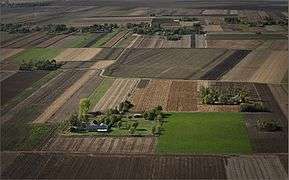
Serbia has very favourable natural conditions (land and climate) for varied agricultural production. It has 5,056,000 ha of agricultural land (0.7 ha per capita), out of which 3,294,000 ha is arable land (0.45 ha per capita).[190] In 2013, Serbia exported agricultural and food products worth $2.8 billion, and the export-import ratio was 180%.[191] Agricultural exports constitute one-fifth of all Serbia's sales on the world market. Serbia is one of the largest provider of frozen fruit to the EU (largest to the French market, and 2nd largest to the German market).[192] Agricultural production is most prominent in Vojvodina on the fertile Pannonian Plain. Other agricultural regions include Mačva, Pomoravlje, Tamnava, Rasina, and Jablanica.[193] In the structure of the agricultural production 70% is from the crop field production, and 30% is from the livestock production.[193] Serbia is world's second largest producer of plums (582,485 tons; second to China), second largest of raspberries (89,602 tons, second to Poland), it is also significant producer of maize (6.48 million tons, ranked 32nd in the world) and wheat (2.07 million tons, ranked 35th in the world).[37][194] Other important agricultural products are: sunflower, sugar beet, soybean, potato, apple, pork meat, beef, poultry and dairy.
There are 56,000 ha of vineyards in Serbia, producing about 230 million litres of wine annually.[37][190] Most famous viticulture regions are located in Vojvodina and Šumadija.
Industry
The industry is the economy sector which was hardest hit by the UN sanctions and trade embargo and NATO bombing during the 1990s and transition to market economy during the 2000s.[195] The industrial output saw dramatic downsizing: in 2013 it is expected to be only a half of that of 1989.[196] Main industrial sectors include: automotive, mining, non-ferrous metals, food-processing, electronics, pharmaceuticals, clothes.
Automotive industry (with FIAT as a forebearer) is dominated by cluster located in Kragujevac and its vicinity, and contributes to export with about $2 billion.[197] Serbia's mining industry is comparatively strong: Serbia is the 18th largest producer of coal (7th in the Europe) extracted from large deposits in Kolubara and Kostolac basins; it is also world's 23rd largest (3rd in Europe) producer of copper which is extracted by RTB Bor, a large domestic copper mining company; significant gold extraction is developed around Majdanpek. Serbia notably manufactures intel smartphones named Tesla smartphones.[198]
Food industry is well known both regionally and internationally and is one of the strong points of the economy.[199] Some of the international brand-names established production in Serbia: PepsiCo and Nestlé in food-processing sector; Coca-Cola (Belgrade), Heineken (Novi Sad) and Carlsberg (Bačka Palanka) in beverage industry; Nordzucker in sugar industry.[192] Clothing and textile industry has seen a surge in recent years with significant greenfeild investments by foreign companies: Benneton in Niš, Geox in Vranje, Calzedonia in Sombor, Falke in Leskovac and others.Serbia's electronics industry had its peak in the 1980s and the industry today is only a third of what it was back then, but has witnessed a something of revival in last decade with investments of companies such as Siemens (wind turbines) in Subotica, Panasonic (lighting devices) in Svilajnac, and Gorenje (electrical home appliances) in Valjevo.[200] The pharmaceutical industry in Serbia comprises 20 manufacturers of generic drugs, of which Hemofarm in Vršac and Galenika in Belgrade, account for 80% of production volume. Domestic production meets over 60% of the local demand.[201]
Energy
Energy sector is one of the largest and most important sectors to the country's economy. Serbia is net exporter of electricity and importer of key fuels (such as oil and gas).
Serbia has abundance of one natural fuel (coal) and relatively significant but not sufficient of the others (oil and gas). Serbia's proven reserves of 5.5 billion tons of coal lignite are 5th largest in the world (second in Europe, after Germany).[202][203] Coal is found in two large deposits: Kolubara (4 billion tons of reserves) and Kostolac (1.5 billion tons).[202] Despite being small on a world scale, Serbia's oil and gas resources (77.4 million tons of oil equivalent and 48.1 billion cubic meters, respectively) have a certain regional importance since they are largest in the region of former Yugoslavia as well as the Balkans (excluding Romania).[204] Almost 90% of the discovered oil and gas are to be found in Banat and those oil and gas fields are by size among the largest in the Pannonian basin but the average on a European scale.[205]

The production of electricity in 2012 in Serbia was 36.06 billion kilowatt-hours (KWh), while the final electricity consumption amounted to 35.5 billion kilowatt-hours (KWh).[206] Most of the electricity produced comes from thermal-power plants (72.7% of all electricity) and to a lesser degree from hydroelectric-power plants (27.3%).[207] There are 6 lignite-operated thermal-power plants with an installed power of 3,936 MW; largest of which are 1,502 MW-Nikola Tesla 1 and 1,160 MW-Nikola Tesla 2, both in Obrenovac.[208] Total installed power of 9 hydroelectric-power plants is 2,831 MW, largest of which is Đerdap 1 with capacity of 1,026 MW.[209] In addition to this, there are mazute and gas-operated thermal-power plants with an installed power of 353 MW.[210] The entire production of electricity is concentrated in Elektroprivreda Srbije (EPS), public electric-utility power company.
The current oil production in Serbia amounts to over 1.1 million tons of oil equivalent[211] and satisfies some 43% of country's needs while the rest is imported.[212] National petrol company, Naftna Industrija Srbije (NIS), was acquired in 2008 by Gazprom Neft. The company has completed $700 million modernisation of oil-refinery in Pančevo (capacity of 4.8 million tons) and is currently in the midst of converting oil refinery in Novi Sad into lubricants-only refinery. It also operates network of 334 filling stations in Serbia (74% of domestic market) and additional 36 stations in Bosnia and Herzegovina, 31 in Bulgaria, and 28 in Romania.[213][214] There are 155 kilometers of crude oil pipelines connecting Pančevo and Novi Sad refineries as a part of trans-national Adria oil pipeline.[215]
Serbia is heavily dependent on foreign sources of natural gas, with only 17% coming from domestic production (totalling 491 million cubic meters in 2012) and the rest is imported, mainly from Russia (via gas pipelines that run through Ukraine and Hungary).[212] Srbijagas, public gas company, operates the natural gas transportation system which comprise 3,177 kilometers of trunk and regional natural gas pipelines and a 450 million cubic meter underground gas storage facility at Banatski Dvor.[216]
Transport
Serbia has a strategic transportation location since the country's backbone, Morava Valley, represents by far the easiest route of land travel from continental Europe to Asia Minor and the Near East.
Serbian road network carries the bulk of traffic in the country. Total length of roads is 40,845 km, of which 1,372 km are "class-1a state roads" (i.e. major national roads, including some 675 km of motorways); 4,153 km are "class-1b state roads"; 11,540 km are "class-2 state roads" (regional roads) and 23,780 km are "municipal roads".[217][218] The road network, except for the most of class-1a roads, are of comparatively lower quality to the Western European standards because of lack of financial resources for their maintenance in the last 20 years.
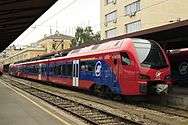 Serbian Railways |
 Belgrade Nikola Tesla Airport |
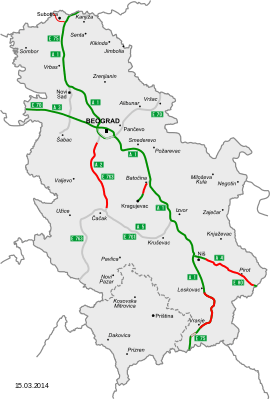
There are 241 kilometers of motorways (autoputevi) under construction, which are all due to be completed by 2017: two sections 40 km-long of the A1 motorway (from south of Leskovac to Bujanovac), 102 km-long segment of A2 (between Obrenovac and Čačak), and 70 kilometers on the A4 (east of Niš to the Bulgarian border).[219] Work on the construction of the remaining part of A2 (52 km-long sections Belgrade–Obrenovac and Čačak–Požega) is set to commence in 2016 and be completed by 2018 and 2019, respectively.[219] Coach transport is very extensive: almost every place in the country is connected by bus, from largest cities to the villages; in addition there are international routes (mainly to countries of Western Europe with large Serb diaspora). Routes, both domestic and international, are served by more than 100 bus companies, biggest of which are Lasta and Niš-Ekspres. As of 2011, there are 1,677,510 registered passenger cars or 1 passenger car per 4.3 inhabitants.[37]
Serbia has 3,819 kilometers of rail tracks, of which 1,279 are electrified and 283 kilometers are double-track railroad.[37] The major rail hub is Belgrade (and to a lesser degree Niš), while the most important railroads include: Belgrade–Bar (Montenegro), Belgrade–Šid–Zagreb (Croatia)/Belgrade–Niš–Sofia (Bulgaria) (part of Pan-European Corridor X), Belgrade–Subotica–Budapest (Hungary) and Niš–Thessaloniki (Greece). Although still a major mode of freight transportation, railroads face increasing problems with the maintenance of the infrastructure and lowering speeds. All rail services are operated by public rail company, Serbian Railways.[220] There are only two international airports with regular passenger traffic: Belgrade Nikola Tesla Airport served 4.77 million passengers in 2015, and is a hub of flagship carrier Air Serbia which carried some 2.55 million passengers in 2015.[221][222] Niš Constantine the Great Airport is mainly catering low-cost airlines.[223]
Serbia has a developed inland water transport since there are 1,716 kilometers of navigable inland waterways (1,043 km of navigable rivers and 673 km of navigable canals), which are almost all located in northern third of the country.[37] The most important inland waterway is the Danube (part of Pan-European Corridor VII). Other navigable rivers include Sava, Tisza, Begej and Timiş River, all of which connect Serbia with Northern and Western Europe through the Rhine–Main–Danube Canal and North Sea route, to Eastern Europe via the Tisza, Begej and Danube Black Sea routes, and to Southern Europe via the Sava river. More than 2.1 million tons of cargo were transported on Serbian rivers and canals in 2011 while the largest river ports are: Belgrade, Novi Sad, Pančevo, Smederevo, Prahovo and Šabac.[37][224]
Telecommunications
Fixed telephone lines connect 89% of households in Serbia, and with about 9.1 million users the number of cellphones surpasses the total population of Serbia by 29%. The largest mobile operator is Telekom Srbija with 4.2 million subscribers, followed by Telenor with 2.9 million users and Vip mobile with about 2 million.[225] Some 64.7% of households have Internet connection,[226] while practically the same percentage (64.2%) are provided with pay television services (i.e. 37% cable television, 16% IPTV, and 11% satellite).[225] Digital television transition has been completed in 2015 with DVB-T2 standard for signal transmission.[227][228]
Tourism
Serbia is not a mass-tourism destination but nevertheless has a diverse range of touristic products.[229] In 2015, total of over 2.4 million tourists were recorded in accommodations, of which some 1.1 million were foreign.[230] Foreign exchange earnings from tourism were estimated at $1.14 billion.[231]
Tourism is mainly focused on the mountains and spas of the country, which are mostly visited by domestic tourists, as well as Belgrade which is preferred choice of foreign tourists.[232] The most famous mountain resorts are Kopaonik, Stara Planina, and Zlatibor. There are also many spas in Serbia, the biggest of which is Vrnjačka Banja, Soko Banja, and Banja Koviljača. City-break and conference tourism is developed in Belgrade (which was visited by 517,401 foreign tourists in 2013, more than a half of all international visits to the country) and to a lesser degree Novi Sad.[233] Other touristic products that Serbia offer are natural wonders like Đavolja varoš,[234] Christian pilgrimage to the many Orthodox monasteries across the country[235] and the river cruising along the Danube. There are several internationally popular music festivals held in Serbia, such as EXIT (with 25–30,000 foreign visitors coming from 60 different countries) and the Guča trumpet festival.[236]

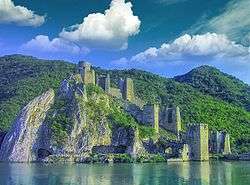


Education and science
According to 2011 census, literacy in Serbia stands at 98% of population while computer literacy is at 49% (complete computer literacy is at 34.2%).[237] Same census showed the following levels of education: 16.2% of inhabitants have higher education (10.6% have bachelors or master's degrees, 5.6% have an associate degree), 49% have a secondary education, 20.7% have an elementary education, and 13.7% have not completed elementary education.[238]
Education in Serbia is regulated by the Ministry of Education and Science. Education starts in either preschools or elementary schools. Children enroll in elementary schools at the age of seven. Compulsory education consists of eight grades of elementary school. Students have the opportunity to attend gymnasiums and vocational schools for another four years, or to enroll in vocational training for 2 to 3 years. Following the completion of gymnasiums or vocational schools, students have the opportunity to attend university.[239] Elementary and secondary education are also available in languages of recognised minorities in Serbia, where classes are held in Hungarian, Slovak, Albanian, Romanian, Rusyn, Bulgarian as well as Bosnian and Croatian languages.


There are 17 universities in Serbia (eight public universities with a total number of 85 faculties and nine private universities with 51 faculties).[241] In 2010/2011 academic year, 181,362 students attended 17 universities (148,248 at public universities and some 33,114 at private universities) while 47,169 attended 81 "higher schools".[37] Public universities in Serbia are: the University of Belgrade (oldest, founded in 1808, and largest university with 89,827 undergraduates and graduates[242]), University of Novi Sad (founded in 1960 and with student body of 47,826[243]), University of Niš (founded in 1965; 27,000 students), University of Kragujevac (founded in 1976; 14,000 students), University of Priština – Kos. Mitrovica, Public University of Novi Pazar as well as two specialist universities – University of Arts and University of Defence. Largest private universities include John Naisbitt University and Singidunum University, both in Belgrade, and Educons University in Novi Sad. Public universities tend to be of a better quality and therefore more renowned than private ones. Thе University of Belgrade (placed in 301–400 bracket on 2013 Shanghai Ranking of World Universities, being best-placed university in Southeast Europe after those in Athens and Thessaloniki) and University of Novi Sad are generally considered as the best institutions of higher learning in the country.[244]
Serbia spent 0.64% of GDP on scientific research in 2012, which is one of the lowest R&D budgets in Europe.[245] Serbia has a long history of excellence in maths and computer sciences which has created a strong pool of engineering talent, although economic sanctions during the 1990s and chronic underinvestment in research forced many scientific professionals to leave the country.[246] Nevertheless, there are several areas in which Serbia still excels such as growing information technology sector, which includes software development as well as outsourcing. It generated $200 million in exports in 2011, both from international investors and a significant number of dynamic homegrown enterprises.[247] In 2005 the global technology giant, Microsoft, founded the Microsoft Development Center, only its fourth such centre in the world. Among the scientific institutes operating in Serbia, the largest are the Mihajlo Pupin Institute and Vinča Nuclear Institute, both in Belgrade. The Serbian Academy of Sciences and Arts is a learned society promoting science and arts from its inception in 1841.[248] With a strong science and technological ecosystem, Serbia has produced a number of renowned scientists that have greatly contributed to the field of science and technology.
- Nikola Tesla, electrical engineer and inventor, best known for his contributions to the design of the modern alternating current (AC) electricity supply system including the AC induction motor.[249] The tesla is the SI derived unit of magnetic flux density and was named after Tesla.[250]
- Mihajlo Pupin discovered a means of greatly extending the range of long-distance telephone communication by placing loading coils of wire (known as Pupin coils) at predetermined intervals along the transmitting wire (known as "pupinization").[251]
- Milutin Milanković is known for his theory of ice ages, suggesting a relationship between the Earth's long-term climate changes and periodic changes in its orbit, now known as Milankovitch cycles.
- Mihailo Petrović is known for having contributed significantly to differential equations and phenomenology, as well as inventing one of the first prototypes of an analog computer.
Culture
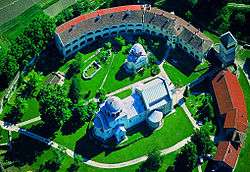
For centuries straddling the boundaries between East and West, the territory of Serbia had been divided among the Eastern and Western halves of the Roman Empire; then between Byzantium and the Kingdom of Hungary; and in the Early modern period between the Ottoman Empire and the Habsburg Empire. These overlapping influences have resulted in cultural varieties throughout Serbia; its north leans to the profile of Central Europe, while the south is characteristic of the wider Balkans and even the Mediterranean. The Byzantine influence on Serbia was profound, firstly through the introduction of Eastern Christianity (Orthodoxy) in the Early Middle Ages. The Serbian Orthodox Church has had an enduring status in Serbia, with the many Serbian monasteries constituting the most valuable cultural monuments left from Serbia in the Middle Ages.
Serbia has five cultural monuments inscribed in the list of UNESCO World Heritage: the early medieval capital Stari Ras and the 13th-century monastery Sopoćani; the 12th-century Studenica monastery; the Roman complex of Gamzigrad–Felix Romuliana; medieval tombstones Stećci; and finally the endangered Medieval Monuments in Kosovo (the monasteries of Visoki Dečani, Our Lady of Ljeviš, Gračanica and Monastery of the Patriarchate of Peć).
There are two literary monuments on UNESCO's Memory of the World Programme: the 12th-century Miroslav Gospel, and scientist Nikola Tesla's valuable archive. The slava (patron saint veneration) is inscribed on UNESCO Intangible Cultural Heritage Lists. The Ministry of Culture and Information is tasked with preserving the nation's cultural heritage and overseeing its development. Further activities supporting development of culture are undertaken at local government level.
Art

Traces of Roman and early Byzantine Empire architectural heritage are found in many royal cities and palaces in Serbia, like Sirmium, Felix Romuliana and Justiniana Prima.
Serbian monasteries, with their fresco and icon paintings, are the pinnacle of Serbian medieval art. At the beginning, they were under the influence of Byzantine Art which was particularly felt after the fall of Constantinople in 1204, when many Byzantine artists fled to Serbia. The most noted of these monasteries is Studenica (built around 1190). It was a model for later monasteries, like the Mileševa, Sopoćani, Žiča, Gračanica and Visoki Dečani. The most famous Serbian medieval fresco is the Mironosnice na Grobu (or the "White Angel") from the Mileševa monastery.[253] In the end of 14th and the 15th centuries, autochotonous architectural style known as Morava style evolved in area around Morava Valley. A characteristic of this style was the wealthy decoration of the frontal church walls. Examples of this include Manasija, Ravanica and Kalenić monasteries. Country is dotted with many well-preserved medieval fortifications and castles such as Smederevo Fortress (largest lowland fortress in Europe), Golubac, Maglič, and Ram.
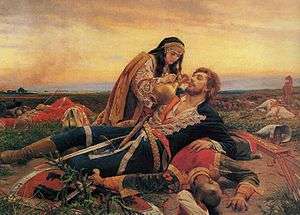
During the time of Ottoman occupation, Serbian art was virtually non-existent, with the exception of several Serbian artists who lived in the lands ruled by the Habsburg Monarchy. Traditional Serbian art showed some Baroque influences at the end of the 18th century as shown in the works of Nikola Nešković, Teodor Kračun, Zaharije Orfelin and Jakov Orfelin.[255]
Serbian painting showed the influence of Biedermeier, Neoclassicism and Romanticism during the 19th century. The most important Serbian painters of the first half of the 20th century were Paja Jovanović and Uroš Predić of Realism, Cubist Sava Šumanović, Milena Pavlović-Barili and Nadežda Petrović of Impressionism, Expressionist Milan Konjović. Noted painters of the second half of 20th century include Marko Čelebonović, Petar Lubarda, Milo Milunović, and Vladimir Veličković.[256]
Anastas Jovanović was one of the earliest photographes in the world, while Marina Abramović is one of the world leading performance artists. Pirot carpet is known as one of the most important traditional handicrafts in Serbia.
There are around 100 art museums in Serbia, of which the most prominent is the National Museum of Serbia, founded in 1844; it houses one of the largest art collections in the Balkans with more than 400,000 exhibits, over 5,600 paintings and 8,400 drawings and prints, including many foreign masterpiece collections. Other art museums of note are Museum of Contemporary Art in Belgrade and Museum of Vojvodina in Novi Sad.
Literature
The beginning of Serbian literacy dates back to the activity of the brothers Cyril and Methodius in the Balkans. Monuments of Serbian literacy from the early 11th century can be found, written in Glagolitic. Starting in the 12th century, books were written in Cyrillic. From this epoch, the oldest Serbian Cyrillic book editorial are the Miroslav Gospels. The Miroslav Gospels are considered to be the oldest book of Serbian medieval history.
Notable medieval authors include Saint Sava, Nun Jefimija, Stefan Lazarević, Constantine of Kostenets and others.[258] Baroque trends in Serbian literature emerged in the late 17th century. Notable Baroque-influenced authors were Gavril Stefanović Venclović, Jovan Rajić, Zaharije Orfelin, Andrija Zmajević and others.[259] Dositej Obradović was the most prominent figure of the Age of Enlightenment, while the most notable Classicist writer was Jovan Sterija Popović, although his works also contained elements of Romanticism.[260] In the era of national revival, in the first half of the 19th century, Vuk Stefanović Karadžić collected Serbian folk literature, and reformed the Serbian language and spelling,[261] paving the way for Serbian Romanticism. The first half of the 19th century was dominated by Romanticism, with Branko Radičević, Đura Jakšić, Jovan Jovanović Zmaj and Laza Kostić being the most notable representatives, while the second half of the century was marked by Realist writers such as Milovan Glišić, Laza Lazarević, Simo Matavulj, Stevan Sremac, Vojislav Ilić, Branislav Nušić, Radoje Domanović and Borisav Stanković.
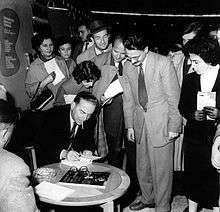
The 20th century was dominated by the prose writers Miloš Crnjanski, Isidora Sekulić, Ivo Andrić (who was awarded Nobel Prize in Literature in 1961), Branko Ćopić, Miodrag Bulatović, Meša Selimović, Borislav Pekić, Danilo Kiš, Dobrica Ćosić, Aleksandar Tišma, Dragoslav Mihailović, Milorad Pavić and ohers.[262][263] There were also many valuable poetic achievements, as seen by the writings of Milan Rakić, Jovan Dučić, Vladislav Petković Dis, Rastko Petrović, Stanislav Vinaver, Dušan Matić, Desanka Maksimović, Branko Miljković, Vasko Popa, Oskar Davičo, Miodrag Pavlović, Stevan Raičković, and others.[264] Most notable contemporary authors include David Albahari, Svetislav Basara, Goran Petrović, Vladimir Arsenijević, Zoran Živković and others.
There are 551 public libraries in Serbia (excluding Kosovo), the biggest of which are two national libraries: National Library of Serbia in Belgrade with funds of about 5 million volumes, and Matica Srpska (oldest Serbian cultural institution, founded in 1826) in Novi Sad with nearly 3.5 million volumes.[265][266] In 2010, there were 10,989 books and brochures published.[37] The book publishing market is dominated by several major publishers such as Laguna and Vulkan (both of which operate their own bookstore chains) and the industry's centerpiece event, annual Belgrade Book Fair, is the most visited cultural event in Serbia with 158,128 visitors in 2013.[267] The highlight of the literary scene is awarding of NIN Prize, given every January since 1954 for the best newly published novel in Serbian language (during times of Yugoslavia, in Serbo-Croatian language).[268]
Music
Composer and musicologist Stevan Stojanović Mokranjac is considered the founder of modern Serbian music.[269][270] The Serbian composers of the first generation Petar Konjović, Stevan Hristić, and Miloje Milojević maintained the national expression and modernized the romanticism into the direction of impressionism. Other famous classical Serbian composers include Isidor Bajić, Stanislav Binički and Josif Marinković.[271] There are three opera houses in Serbia: Opera of the National Theatre and Madlenianum Opera, both in Belgrade, and Opera of the Serbian National Theatre in Novi Sad. Four symphonic orchestra operate in the country: Belgrade Philharmonic Orchestra, Niš Symphony Orchestra, Symphonic Orchestra of Radio Television of Serbia, and Novi Sad Philharmonic Orchestra. The Choir of Radio Television of Serbia is a leading vocal ensemble in the country.[272] The BEMUS is one of the most prominent classical music festivals in the South East Europe.
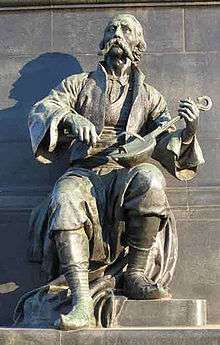
Traditional Serbian music includes various kinds of bagpipes, flutes, horns, trumpets, lutes, psalteries, drums and cymbals. The kolo is the traditional collective folk dance, which has a number of varieties throughout the regions. The most popular are those from Užice and Morava region. Sung epic poetry has been an integral part of Serbian and Balkan music for centuries. In the highlands of Serbia these long poems are typically accompanied on a one-string fiddle called the gusle, and concern themselves with themes from history and mythology. There are records of gusle being played at the court of the 13th-century King Stefan Nemanjić.[273]
The Serbian rock which was during the 1960s, 1970s and 1980s part of former Yugoslav rock scene, used to be well developed, featuring various rock genres, and was well covered in the media, which included numerous magazines, radio and TV shows. During the 1990s and 2000s popularity of rock music declined in Serbia, and although several major mainstream acts managed to sustain their popularity, an underground and independent music scene developed. The most notable Serbian rock acts include Bajaga i Instruktori, Đorđe Balašević, Disciplina Kičme, Ekatarina Velika, Električni Orgazam, Galija, Idoli, Kerber, Korni Grupa, Partibrejkers, Pekinška Patka, Pop Mašina, Rambo Amadeus, Riblja Čorba, Smak, Šarlo Akrobata, Van Gogh, YU Grupa, and others.

Pop music has mainstream popularity. Željko Joksimović won second place at the 2004 Eurovision Song Contest and Marija Šerifović managed to win the 2007 Eurovision Song Contest with the song "Molitva", and Serbia was the host of the 2008 edition of the contest. Most popular pop singers include likes of Zdravko Čolić, Vlado Georgiev, Nataša Bekvalac among others.
Turbo-folk music is subgenre that has developed in Serbia in the late 1980s and the beginning of the 1990s and has since enjoyed an immense popularity. It is a blend of folk music with pop and/or dance elements and can be seen as a result of the urbanization of folk music. In recent period turbo-folk featured even more pop music elements, and some of the performers were labeled as pop-folk. The most famous among them are Ceca (often considered to be the biggest music star of Serbia), Jelena Karleuša, Aca Lukas, Seka Aleksić, Dragana Mirković, Dara Bubamara, Indira Radić and Lepa Brena, arguably the most prominent performer of former Yugoslavia.
Balkan Brass, or truba ("trumpet") is a popular genre, especially in Central and Southern Serbia where Balkan Brass originated. The music has its tradition from the First Serbian Uprising. The trumpet was used as a military instrument to wake and gather soldiers and announce battles, the trumpet took on the role of entertainment during downtime, as soldiers used it to transpose popular folk songs. When the war ended and the soldiers returned to the rural life, the music entered civilian life and eventually became a music style, accompanying births, baptisms, weddings, and funerals. There are two main varieties of this genre, one from Western Serbia and the other from Southern Serbia. The best known Serbian Brass musician is Boban Marković, also one of the biggest names in the world of modern brass band bandleaders.
Most popular music festival are Guča Trumpet Festival with over 300,000 annual visitors and EXIT in Novi Sad ("The best European festival" in 2007 by UK Festival Awards and Yourope – the European Association of the 40 largest festivals in Europe) with 200,000 visitors in 2013.[274][275] Other festivals include Nišville Jazz Festival in Niš and Gitarijada rock festival in Zaječar.
Theatre and cinema
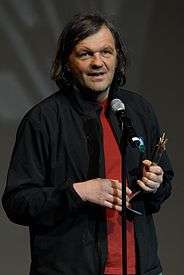
Serbia has a well-established theatrical tradition with Joakim Vujić considered the founder of modern Serbian theater.[276] Serbia has 38 professional theatres, the most important of which are National Theatre in Belgrade, Serbian National Theatre in Novi Sad, National Theatre in Subotica, National Theatre in Niš and Knjaževsko-srpski teatar in Kragujevac (the oldest theatre in Serbia, established in 1835). The Belgrade International Theatre Festival – BITEF, founded in 1967, is one of the oldest theater festivals in the world, and it has become one of the five biggest European festivals.[277] Sterijino pozorje is, on the other hand, festival showcasing national drama plays. The most important Serbian playwrighters were Jovan Sterija Popović and Branislav Nušić, while today renowned names are Dušan Kovačević and Biljana Srbljanović.[278]
The Serbian cinema is one of the most dynamic smaller European cinematographies. Serbia's film industry is heavily subsidised by the government, mainly through grants approved by the Film Centre of Serbia. In 2011, there were 17 domestic feature films produced.[279] There are 20 operating cinemas in the country, of which 10 are multiplexes, with total attendance exceeding 2.6 million and comparatively high percentage of 32.3% of total sold tickets for domestic films.[280][281] Modern PFI Studios located in Šimanovci is nowadays Serbia's only film studio complex; it consists of 9 state-of-the-art sound stages and attracts mainly international productions, primarily American and West European.[282] The Yugoslav Film Archive used to be former Yugoslavia's and now is Serbia national film archive – with over 95 thousand film prints, it is among five largest film archives in the world.[283]
Serbian cinema dates back to 1896 with the release of the oldest movie in the Balkans, The Life and Deeds of the Immortal Vožd Karađorđe, a biography about Serbian revolutionary leader, Karađorđe.[284][285]
The most famous Serbian filmmaker is Emir Kusturica who won two Golden Palms for Best Feature Film at the Cannes Film Festival, for When Father Was Away on Business in 1985 and then again for Underground in 1995.[286] Other renowned directors include Goran Paskaljević, Dušan Makavejev, Goran Marković, Srđan Dragojević and Srdan Golubović among others. Steve Tesich, Serbian-American screenwriter, won the Academy Award for Best Original Screenplay in 1979 for the movie Breaking Away.
Media
The freedom of the press and the freedom of speech are guaranteed by the constitution of Serbia.[287] Serbia is ranked 54th out of 180 countries in the 2014 Press Freedom Index report compiled by Reporters Without Borders.[288] Both reports noted that media outlets and journalists continue to face partisan and government pressure over editorial policies. Also, the media are now more heavily dependent on advertising contracts and government subsidies to survive financially.[289]
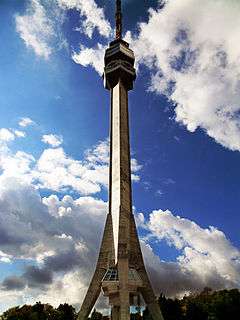
According to AGB Nielsen Research in 2009, Serbs on average watch five hours of television per day, making it the highest average in Europe.[290] There are seven nationwide free-to-air television channels, with public broadcaster Radio Television of Serbia (RTS) operating three (RTS1, RTS2 and RTS3) and remaining four are private broadcasters: Prva, B92, Pink and Happy TV. Viewing shares for these channels in 2012 were as follows: 23.5% for RTS1, 19.6% for Pink, 16.1% for Prva, 8.1% for B92, 3.6% for RTS2, and 2.8% for Happy TV.[291] There are 28 regional television channels and 74 local television channels.[37] Besides terrestrial channels there are dozens Serbian television channels available only on cable or satellite.
There are 220 radio stations in Serbia.[37] Out of these, seven are radio stations with national coverage, including three of public broadcaster Radio Television of Serbia (Radio Belgrade 1, Radio Belgrade 2/Radio Belgrade 3 and Radio Belgrade 202), and four private ones (Radio S1, Radio S2, Play Radio, and Radio Hit FM). Also, there are 49 regional stations and 162 local stations.[292]
There are 340 newspapers published in Serbia[37] of which 13 are daily newspapers. Dailies Politika and Danas are Serbia's papers of record, former being the oldest newspaper in the Balkans, founded in 1904.[293] Highest circulation newspapers are tabloids Večernje Novosti, Blic, Kurir, and Informer, all with more than 100,000 copies sold.[294] There are one daily newspaper devoted to sports - Sportski žurnal, one business daily Privredni pregled, two regional newspapers (Dnevnik published in Novi Sad and Narodne novine from Niš), one daily on Hungarian language (Magyar Szo published in Subotica), and a free newspaper of 24 sata, distributed only in Belgrade and Novi Sad.
There are 1,262 magazines published in the country.[37] Those include weekly news magazines NIN, Vreme and Nedeljnik, popular science magazine of Politikin Zabavnik, women's Lepota & Zdravlje, auto magazine SAT revija, IT magazine Svet kompjutera. In addition, there is a wide selection of Serbian editions of international magazines, such as Cosmopolitan, Elle, Grazia, Men's Health, National Geographic, Le Monde diplomatique, Playboy, Hello! and others.
There are two main news agencies, Beta and Fonet.
As of 2014, the most visited websites in Serbian (mainly on the .rs domain) are the Serbian version of Google followed by online editions of printed daily Blic, news web-portal of B92 broadcaster, news portal of printed daily Kurir and classifieds KupujemProdajem.[295]
Cuisine
Serbian cuisine is largely heterogeneous, sharing characteristics of the Balkans (especially former Yugoslavia), the Mediterranean (Greek in particular), Turkish, and Central European (especially Austrian and Hungarian) cuisines. Food is very important in Serbian social life, particularly during religious holidays such as Christmas, Easter and feast days i.e. slava.[296]
Staples of the Serbian diet include bread, meat, fruits, vegetables, and dairy products. Bread is the basis of all Serbian meals, and it plays an important role in Serbian cuisine and can be found in religious rituals. A traditional Serbian welcome is to offer bread and salt to guests. Meat is widely consumed, as is fish. Serbian specialties include ćevapčići (caseless sausages made of minced meat, which is always grilled and seasoned), pljeskavica, sarma, kajmak (a dairy product similar to clotted cream), gibanica (cheese and kajmak pie), ajvar (a roasted red pepper spread), proja (cornbread), and kačamak (corn-flour porridge).[297]
Serbians claim their country as the birthplace of rakia (rakija), a highly alcoholic drink primarily distilled from fruit. Rakia in various forms is found throughout the Balkans, notably in Bulgaria, Croatia, Slovenia, Montenegro, Hungary and Turkey. Slivovitz (šljivovica), a plum brandy, is a type of rakia which is considered the national drink of Serbia.[298]
Sports
Sports play an important role in Serbian society, and the country has a strong sporting history. The most popular sports in Serbia are football, basketball, tennis, volleyball, water polo and handball.
Professional sports in Serbia are organized by sporting federations and leagues (in case of team sports). One of particularities of Serbian professional sports is existence of many multi-sports clubs (called "sports societies"), biggest and most successful of which are Red Star, Partizan, and Beograd in Belgrade, Vojvodina in Novi Sad, Radnički in Kragujevac, Spartak in Subotica.
.jpg)
Football is the most popular sport in Serbia, and the Football Association of Serbia with 146,845 registered players, is the largest sporting association in the country.[299] Dragan Džajić was officially recognized as "the best Serbian player of all times" by the Football Association of Serbia, and more recently the likes of Nemanja Vidić, Dejan Stanković and Branislav Ivanović play for the elite clubs of Europe, developing the nation's reputation as one of the world's biggest exporters of footballers.[300] The Serbia national football team lacks relative success although it qualified for three of the last four FIFA World Cups. Serbia national youth football teams have won 2013 U-19 European Championship and 2015 U-20 World Cup. The two main football clubs in Serbia are Red Star (winner of the 1991 European Cup) and Partizan (finalist of the 1966 European Cup), both from Belgrade. The rivalry between the two clubs is known as the "Eternal Derby", and is often cited as one of the most exciting sports rivalries in the world.[301]
Serbia is one of the traditional powerhouses of world basketball, as Serbia men's national basketball team have won two World Championships (in 1998 and 2002), three European Championships (1995, 1997, and 2001) and two Olympic silver medals (in 1996 and 2016) as well. The women's national basketball team won the European Championship in 2015 and Olympic bronze medal in 2016. A total of 22 Serbian players have played in the NBA in last two decades, including Predrag "Peja" Stojaković (three-time NBA All-Star) and Vlade Divac (2001 NBA All-Star and FIBA Hall of Famer). The renowned "Serbian coaching school" produced many of the most successful European basketball coaches of all times, such as Željko Obradović, who won a record 8 Euroleague titles as a coach. KK Partizan basketball club was the 1992 European champion.
Recent success of Serbian tennis players has led to an immense growth in the popularity of tennis in Serbia. Novak Đoković, twelve-time Grand Slam champion, finished in 2011, 2012, 2014 and 2015 as No. 1 in the world and is also currently No. 1 in the ATP Rankings.[302] Ana Ivanovic (champion of 2008 French Open) and Jelena Janković were both ranked No. 1 in the WTA Rankings. There were two No. 1 ranked-tennis double players as well: Nenad Zimonjić (three-time men's double and four-time mixed double Grand Slam champion) and Slobodan Živojinović. The Serbia men's tennis national team won the 2010 Davis Cup while Serbia women's tennis national team reached the final at 2012 Fed Cup.[303]
Serbia is one of the leading volleyball countries in the world. Its men's national team won the gold medal at 2000 Olympics, and has won the European Championship twice. The women's national volleyball team won the European Championship in 2011 and Olympic silver medal in 2016..
The Serbia men's national water polo team is the second most successful national team after Hungary, having won Olympic gold medal in 2016, three World Championships (2005, 2009 and 2015), and six European Championships in 2001, 2003, 2006, 2012, 2014 and 2016 respectively.[304] VK Partizan has won a joint-record seven European champion titles.
Other noted Serbian athletes include: swimmers Milorad Čavić (2009 World champion on 50 meters butterfly and silver medalist on 100 meters butterfly as well as 2008 Olympic silver medalist on 100 meters butterfly in historic race with American swimmer Michael Phelps) and Nađa Higl (2009 World champion in 200 meters breaststroke – the first Serbian woman to become a world champion in swimming); track and field athlete Ivana Španović (long-jumper; 2016 European champion and bronze medalist at the 2016 Olympics); wrestler Davor Štefanek (2016 Olympic gold medalist), and taekwondoist Milica Mandić (2012 Olympic gold medalist).
Serbia has hosted several major sport competitions in the last ten years, including the 2005 Men's European Basketball Championship, 2005 Men's European Volleyball Championship, 2006 and 2016 Men's European Water Polo Championships, 2009 Summer Universiade, 2012 European Men's Handball Championship, and 2013 World Women's Handball Championship. The most important annual sporting events held in the country are Belgrade Marathon and Tour de Serbie cycling race.
Public holidays
The public holidays in Serbia are defined by the Law of national and other holidays in the Republic of Serbia.
| Date | Name | Local Name | 2015 Date | 2016 Date | Remarks |
|---|---|---|---|---|---|
| 1 January1 | New Year's Day | Nova Godina | 1 January | ||
| 2 January1 | 2 January | ||||
| 7 January | Julian Orthodox Christmas | Božić | 7 January | Serbian Orthodox Church uses the Julian calendar | |
| 15 February1 | Statehood Day | Dan državnosti | 15 February | Anniversary of the First Serbian Uprising in 1804 and the first Serbian Constitution in 1835 | |
| 16 February1 | 16 February | ||||
| See Date of Easter | Orthodox Good Friday | Veliki petak | 10 April | 29 April | Serbian Orthodox Church calculates Easter using Orthodox Computus |
| Orthodox Easter | Vaskrs | 12 April | 1 May | ||
| Orthodox Easter Monday | Vaskrsni ponedeljak | 13 April | 2 May | ||
| 1 May1 | May Day / International Workers' Day | Praznik rada | 1 May | ||
| 2 May1 | 2 May | ||||
| 11 November1 | Armistice Day | Dan primirja | 11 November | ||
1 If any of the non-religious holidays falls on a Sunday, then it extends to the next working day.
See also
 Serbia – Wikipedia book
Serbia – Wikipedia book- International rankings of Serbia
- Outline of Serbia
- Timeline of Serbian history
References
- ↑ http://pod2.stat.gov.rs/ObjavljenePublikacije/Popis2011/Nacionalna%20pripadnost-Ethnicity.pdf
- ↑ "History of Serbia - MIddle Ages". South East European Heritage. Retrieved 17 April 2016.
- 1 2 3 "The World Factbook: Serbia". Central Intelligence Agency. 20 June 2014. Retrieved 18 December 2014.
- 1 2 "Official population projection for Serbia (2016)". Republic of Serbia Statistical Bureau. Retrieved 7 January 2016.
- 1 2 3 4 5 "Report for Selected Countries and Subjects". International Monetary Fund. Retrieved 13 April 2016.
- ↑ "Country Comparison :: Distribution of Family Income – Gini Index". cia.gov. Central Intelligence Agency. Retrieved 30 August 2014.
- ↑ "2015 Human Development Report" (PDF). 15 December 2015. Retrieved 15 December 2015.
- ↑ "The Serbian Revolution and the Serbian State". Steven W. Sowards, Michigan State University Libraries. 11 June 2009. Retrieved 28 April 2010.
- 1 2 "EU leaders grant Serbia candidate status". BBC News. 1 March 2012. Retrieved 2 March 2012.
- 1 2 "EUROPEAN COUNCIL 27/28 JUNE 2013 CONCLUSIONS" (PDF). Council of the European Union. 27 June 2013. Retrieved 28 June 2013.
- ↑ "EU set for Serbia membership talks". BBC News. 28 June 2013. Retrieved 28 June 2013.
- ↑ "Serbia a few steps away from concluding WTO accession negotiations". WTO News. 13 November 2013. Retrieved 13 November 2013.
- 1 2 "Serbia: On the Way to EU Accession". World Bank Group. Retrieved 21 October 2014.
- ↑ "Social Progress Imperative(2015)". SPI. 5 November 2015. Retrieved 5 November 2015.
- ↑ "Institute for Economics and Peace (2015)" (PDF). GPI. 5 October 2015. Retrieved 5 October 2015.
- ↑ "Global Launch of 2015 Human Development Report".
- ↑ "Country Rankings: World & Global Economy Rankings on Economic Freedom".
- ↑ "Serbia: Introduction". Michigan State University. Retrieved 3 October 2014.
- ↑ "Serbia". Southeastern Europe Travel Guide. Balkans 360. Retrieved 3 October 2014.
- ↑ "The World Factbook: Kosovo". Central Intelligence Agency. 19 June 2014. Retrieved 8 January 2015.
- ↑ "Border Police Department". Kosovo Police. Retrieved 8 January 2015.
- ↑ "Uredba o kontroli prelaska administrativne linije prema Autonomnoj pokrajini Kosovo i Metohija" (in Serbian). Official gazette of the Republic of Serbia. Retrieved 8 January 2015.
- ↑ Ivana Carevic, Velimir Jovanovic, STRATIGRAPHIC-STRUCTURAL CHARACTERISTICS OF MAČVA BASIN, UDC 911.2:551.7(497.11), pg. 1
- ↑ "About the Carpathians – Carpathian Heritage Society". Carpathian Heritage Society. Retrieved 28 April 2010.
- ↑ "O Srbiji". Turistickimagazin.com.
- ↑ The Times Atlas of the World (1993). Times Books ISBN 0-7230-0492-7.
- ↑ "Serbia :: Climate". Encyclopædia Britannica Online. 2007. pp. 5 of 71.
- ↑ "CIA – The World Factbook". Cia.gov. Retrieved 24 May 2012.
- ↑ Radovanović, M and Dučić, V, 2002, Variability of Climate in Serbia in the Second Half of the 20th century, EGS XXVII General Assembly, Nice, 21 to 26 April 2002, abstract #2283, 27:2283–, provided by the Smithsonian / NASA Astrophysics Data System
- ↑ "Kossava". Glossary of Meteorology, Second Edition. American Meteorological Society. June 2000. Retrieved 11 March 2007.
- ↑ "Basic Climate Characteristics for the Territory of Serbia". Hydrometeorological Service of Serbia.
- ↑ "Past temperature extremes since the beginning of the measurement" (PDF). Hydrometeorological Service of Serbia. Archived from the original (PDF) on 11 May 2011. Retrieved 5 November 2010.
- ↑ "World Risk Report 2013 – Exposure to natural hazards" (PDF). Alliance Development Works. 2013. pp. 3–4.
- ↑ "River floods Serbia". European Centre for Climate Adaptation. Retrieved 18 December 2014.
- ↑ "Serbia gets $300 million from World Bank to aid floods recovery". Reuters. 4 October 2014. Retrieved 18 December 2014.
- ↑ "Navigation and Transportation: Waterways". Danube Strategy in Serbia. Retrieved 18 December 2014.
- 1 2 3 4 5 6 7 8 9 10 11 12 13 14 "Statistical Yearbook of the Republic of Serbia" (PDF). Statistical Office of the Republic of Serbia. 2012.
- ↑ "::SE "Srbijašume" Belgrade::". Srbijasume.rs. 31 December 2010.
- 1 2 "Serbian biodiversity". IUCN. 7 August 2012.
- ↑ "Serbian Brown Bear". Discoverserbia.org.
- ↑ "CARSKA BARA – Fauna ptica". Carskabara.rs.
- ↑ "Uvac Special Nature Reserve". Uvac.org.rs.
- ↑ "Serbia – European Environment Agency (EEA)". Eea.europa.eu.
- ↑ "Serbia recycling 15% of waste". Blic. Retrieved 28 April 2010.
- ↑ Roksandic M., Mihailovic D., Mercier N., Dimitrijevic V., Morley M.W., Rakocevic Z., Mihailovic B., Guibert P. et Babb J. A human mandible (BH-1) from the Pleistocene deposits of Mala Balanica cave (Sicevo Gorge, Nis, Serbia) // Journal of Human Evolution, 2011, V.61, pp.186-196.
- ↑ Nikola Tasić; Dragoslav Srejović; Bratislav Stojanović (1990). "Vinča and its Culture". In Vladislav Popović. Vinča: Centre of the Neolithic culture of the Danubian region. Belgrade. Retrieved 28 October 2006.
- ↑ "History (Ancient Period)". Official website. Retrieved 10 July 2007.
- ↑ "Kale – Krševica". Kale-krsevica.com. Retrieved 10 July 2011.
- ↑ Andrić, Stanko (October 2002). "Southern Pannonia during the age of the Great Migrations". Scrinia Slavonica. Slavonski Brod, Croatia: Croatian Historical Institute – Department of History of Slavonia, Srijem and Baranja. 2 (1): 117. ISSN 1332-4853. Retrieved 27 February 2012.
- ↑ "Culture in Serbia – Tourism in Serbia, Culture travel to Serbia". VisitSerbia.org. Retrieved 28 April 2010.
- ↑ "Cyril Mango. Byzantium: The Empire of New Rome. Scribner's, 1980". Fordham.edu. Retrieved 14 November 2010.
- ↑ Ćorović 2001, Prvi Period – III
- ↑ Ćorović 2001, Drugi Period – II; Eginhartus de vita et gestis Caroli Magni, p. 192: footnote J10
- ↑ Ćorović 2001, Drugi Period – IV;
- ↑ Ćorović 2001, Drugi Period – V;
- 1 2 Ćorović 2001, Drugi Period – VII;
- ↑ Ćorović 2001, Drugi Period – VIII
- ↑ Ćorović 2001, Treći Period – I;
- ↑ Ćorović 2001, Treći Period – II;
- ↑ "The rule of the Nemanjas and the arrival of the Ottomans". New York Times. 1998. Retrieved 12 October 2012.
- ↑ Agoston-Masters:Encyclopaedia of the Ottoman Empire ISBN 0-8160-6259-5, p.518
- ↑ S.Aksin Somel, Historical Dictionary of the Ottoman Empire, Scarecrow Press, Oxford, 2003, ISBN 0-8108-4332-3 p 268
- ↑ Somel, Selcuk Aksin (2010). The A to Z of the Ottoman Empire. Scarecrow Press. p. 268. ISBN 978-1461731764.
- ↑ Jelavich, Barbara. History of the Balkans: Eighteenth and nineteenth centuries, Volume 1 – page 94 . Cambridge University Press, 1983.
- ↑ Todorovic, Jelena. An Orthodox Festival Book in the Habsburg Empire: Zaharija Orfelin's Festive Greeting to Mojsej Putnik (1757) – pp. 7–8. Ashgate Publishing, 2006
- ↑ Plamen Mitev. Empires and Peninsulas: Southeastern Europe Between Karlowitz and the Peace of Adrianople, 1699–1829 (Vol. 36 of History: Research and Science / Geschichte: Forschung und Wissenschaft Series) LIT Verlag Münster, 2010. ISBN 978-3643106117 p 144
- ↑ Rados Ljusic, Knezevina Srbija
- ↑ Misha Glenny. "The Balkans Nationalism, War and the Great Powers, 1804–1999". The New York Times. Retrieved 6 April 2010.
- ↑ Royal Family. "200 godina ustanka". Royalfamily.org. Archived from the original on 7 February 2010. Retrieved 28 April 2010.
- ↑ Gordana Stokić (January 2003). "Bibliotekarstvo i menadžment: Moguća paralela" (PDF) (in Serbian). Narodna biblioteka Srbije.
- ↑ Ćorović 2001, Novo Doba – VIII
- ↑ L. S. Stavrianos, The Balkans since 1453 (London: Hurst and Co., 2000), pp. 248–50
- ↑ Čedomir Antić (1998). "The First Serbian Uprising". The Royal Family of Serbia. Archived from the original on 26 October 2012.
- ↑ "The Balkan Wars and the Partition of Macedonia". Historyofmacedonia.org. Retrieved 28 April 2010.
- ↑ Balkanski ratovi (Serbian) Archived 4 March 2012 at the Wayback Machine.
- ↑ "Typhus fever on the Eastern front of World War I". Montana State University.
- 1 2 "The Balkan Wars and World War I". Library of Congress Country Studies.
- ↑ "Daily Survey". Ministry of Foreign Affairs of Serbia. 23 August 2004.
- ↑ "Arhiv Srbije – osnovan 1900. godine" (in Serbian).
- ↑ 22 August 2009 Michael Duffy (22 August 2009). "First World War.com – Primary Documents – Vasil Radoslavov on Bulgaria's Entry into the War, 11 October 1915". firstworldwar.com. Retrieved 28 April 2010.
- ↑ Највећа српска победа: Фронт који за савезнике није био битан (Serbian)
- ↑ 22 August 2009 Matt Simpson (22 August 2009). "The Minor Powers During World War I – Serbia". firstworldwar.com. Retrieved 28 April 2010.
- ↑ "Serbian army, August 1914". Vojska.net. Retrieved 28 April 2010.
- ↑ "Tema nedelje: Najveća srpska pobeda: Sudnji rat: POLITIKA". Politika. 14 September 2008. Retrieved 28 April 2010.
- ↑ Тема недеље : Највећа српска победа : Сви српски тријумфи : ПОЛИТИКА (Serbian)
- ↑ Loti, Pierre (30 June 1918). "Fourth of Serbia's population dead". Los Angeles Times (1886–1922). Retrieved 28 April 2010.
- ↑ "Asserts Serbians face extinction". New York Times. 5 April 1918. Retrieved 14 November 2010.
- ↑ Stavrianos, Leften Stavros (January 2000). The Balkans since 1453. p. 624. ISBN 978-1-85065-551-0.
- ↑ Stevan K. Pavlowitch (2008). Hitler's new disorder: the Second World War in Yugoslavia. Columbia University Press. p. 62. ISBN 0-231-70050-4.
- ↑ Karl Savich. "The Kragujevac massacre". Archived from the original on 17 December 2012.
- ↑ "Massacres and Atrocities of WWII in Eastern Europe". Members.iinet.net.au. Retrieved 17 November 2012.
- ↑ "Jewish Heritage Europe – Serbia 2 – Jewish Heritage in Belgrade". Jewish Heritage Europe. Retrieved 28 April 2010.
- ↑ "Ustaša". Britannica OnlineEncyclopedia. Britannica.com. Retrieved 28 April 2010.
- ↑ "Jasenovac". United States Holocaust Memorial Museum. Archived from the original on 16 September 2009. Retrieved 4 January 2010.
- ↑ Jasenovac Jewish Virtual Library. Retrieved 10 August 2008.
- ↑ "Yad Vashem" (PDF). Retrieved 10 July 2011.
- ↑ "Дан сећања на жртве усташког геноцида". Tanjug. Retrieved 20 April 2012.
- ↑ Hitler's new disorder. Google Books. 2008. ISBN 978-0-231-70050-4. Retrieved 16 May 2010.
- ↑ Kočović, Žrtve II sv. rata, 65–79
- ↑ Žerjavić, Gubici stanovništva, 168
- ↑ Zundhauzen, Istorija Srbije, 370
- ↑ PM. "Storia del movimento partigiano bulgaro (1941–1944)". Bulgaria – Italia. Retrieved 28 April 2010.
- ↑ Autor: Tanjug. "Posle rata u Srbiji streljano preko 60.000 civila". Mondo.rs.
- 1 2 Melissa Katherine Bokovoy, Jill A. Irvine, Carol S. Lilly. State-society relations in Yugoslavia, 1945–1992. Scranton, Pennsylvania, USA: Palgrave Macmillan, 1997. p. 295.
- 1 2 3 4 Melissa Katherine Bokovoy, Jill A. Irvine, Carol S. Lilly. State-society relations in Yugoslavia, 1945–1992. Scranton, Pennsylvania, USA: Palgrave Macmillan, 1997. p. 296.
- ↑ Melissa Katherine Bokovoy, Jill A. Irvine, Carol S. Lilly. State-society relations in Yugoslavia, 1945–1992. Scranton, Pennsylvania, USA: Palgrave Macmillan, 1997. p. 301.
- ↑ Branka Magaš (1993). The Destruction of Yugoslavia: tracking the break-up 1980–92 (pp 165–170). Verso. ISBN 978-0-86091-593-5.
- ↑ Engelberg, Stephen (16 January 1992). "Breakup of Yugoslavia Leaves Slovenia Secure, Croatia Shaky". The New York Times. Retrieved 6 April 2010.
- ↑ "Resolution 757 (1992)". UN Security Council 3082nd Meeting. 30 May 1992., see United Nations Security Council Resolution 757
- ↑ "Political Propaganda and the Plan to Create a "State for all Serbs"" (PDF). Retrieved 14 November 2010.
- ↑ Wide Angle, Milosevic and the Media. "Part 3: Dictatorship on the Airwaves." PBS. Quotation from film: "... the things that happened at state TV, warmongering, things we can admit to now: false information, biased reporting. That went directly from Milošević to the head of TV".
- ↑ "History, bloody history". BBC News. 24 March 1999. Retrieved 27 July 2012.
- ↑ Ivan Vejvoda, 'Civil Society versus Slobodan Milošević: Serbia 1991–2000', in Adam Roberts and Timothy Garton Ash (eds.), Civil Resistance and Power Politics: The Experience of Non-violent Action from Gandhi to the Present. Oxford & New York: Oxford University Press, 2009, pp. 295–316. ISBN 978-0-19-955201-6.
- ↑ "Montenegro gets Serb recognition". BBC. 15 June 2006.
- 1 2 "Rift Emerges at the United Nations Over Kosovo". New York Sun. 19 February 2008.
- ↑ "NATO offers "intensified dialogue" to Serbia". B92. 3 April 2008. Retrieved 28 April 2010.
- ↑ "Republic of Serbia – European Union". Ministry of Foreign Affairs. Archived from the original on 6 May 2013. Retrieved 24 June 2013.
- ↑ "Serbia gets EU candidate status, Romania gets nothing". EUobserver. 2 March 2012. Retrieved 24 June 2013.
- ↑ http://www.consilium.europa.eu/uedocs/cms_data/docs/pressdata/en/ec/137634.pdf
- ↑ John says:. "Serbian Constitutional History Part I". Belgraded.com.
- ↑ "Serbia: Constitution of The Republic of Serbia". Wipo.int.
- 1 2 "Responsibilities". predsednik.rs. Retrieved 20 March 2013.
- ↑ "Tomislav Nikolic". BBC News. 21 May 2012. Retrieved 21 May 2012.
- ↑ "Izbori 2012 – Nova vlada položila zakletvu". B92.
- ↑ "National Assembly of the Republic of Serbia | Jurisdiction, competences and duties of the National Assembly". Parlament.gov.rs. 11 June 2008.
- ↑ "Rezultati parlamentarnih izbora u Srbiji 2012 – CESID". eIzbori.
- ↑ "Main information about the Court". Supreme Court of Cassation. Retrieved 20 July 2016.
- ↑ "Zakon o uređenju sudova". Paragraf.rs.
- ↑ "POLIS – Policing Profiles of Participating and Partner States". Polis.osce.org.
- ↑ "About Agency / Security Information Agency". Bia.gov.rs. 27 July 2002.
- ↑ "Serbia Diplomatic List 2012" (PDF). Archived from the original (PDF) on 23 October 2013. Retrieved 27 October 2014.
- ↑ "Diplomatic Missions". Ministry of Foreign Affairs of Serbia. Archived from the original on 5 May 2012. Retrieved 24 May 2012.
- ↑ "Diplomatic Missions in Serbia". Ministry of Foreign Affairs of Serbia. Archived from the original on 20 February 2012. Retrieved 15 September 2012.
- ↑ "Serbia applies for EU membership". Swedish Presidency of the European Union. Archived from the original on 27 January 2010. Retrieved 25 December 2009.
- ↑ "EU grants Serbia candidate status". Times of India. 2 March 2012. Archived from the original on 17 April 2012. Retrieved 24 May 2012.
- ↑ Protest conveyed to France, Britain, Costa Rica, Australia, Albania at the Wayback Machine (archive index)
- 1 2 "Obrambeni sustav Republike Srbije". Obris.org.
- ↑ "Vojska Srbije od sutra i zvanično profesionalna". Politika. 31 December 2010. Retrieved 24 May 2012.
- ↑ "Blic Online | Sa 28.000 vojnika Vojska Srbije među najbrojnijim u regionu". Blic.rs.
- ↑ – Latest information published in Serbia Defense Ministry monthly press "Odbrana" in 1. November 2011 about reserves according to law passed in Serbian parliament. Document contains 20 pages and have information about obligation regarding defending country use of reserve forces and division in to active and passive reserve
- ↑ "Obveznici postali "pasivna rezerva"" (in Serbian). B92. 4 January 2011. Retrieved 21 June 2013.
- ↑ http://www.nato.int/cps/cs/natohq/topics_50100.htm
- ↑ Amnistía Internacional. No hay justicia para las víctimas de los bombardeos de la OTAN. Consultado el 10 de noviembre de 2009.
- ↑ Pike, John. "CSTO members". Global Security. Retrieved 21 October 2014.
- ↑ "Current multinational operations". www.mod.gov.rs. Retrieved 26 April 2013.
- ↑ "Srbija ponovo izvozna vojna sila". Business-dialogue.eu. Retrieved 24 May 2012.
- ↑ "Srpska vojna industrija u usponu". Glas-javnosti. Retrieved 24 May 2012.
- ↑ "Povratak vojne industrije Srbije na svetsku scenu". Blic. Retrieved 24 May 2012.
- ↑ http://www.ccre.org/en/membres/Serbie.htm. Missing or empty
|title=(help) - 1 2 3 "Law on Territorial Organization" (in Serbian). National Assembly of the Republic of Serbia. 29 December 2007. Retrieved 6 October 2013.
- ↑ Hamilton (17 February 2008). "Kosovo declares independence from Serbia". Reuters.
- ↑ Decision on the annulment of the illegitimate acts of the provisional institutions of self-government in Kosovo and Metohija on their declaration of unilateral independence Government of Serbia, 2008
- ↑ "Попис у Србији 2011". Popis2011.stat.rs.
- ↑ "REKOS2011". Esk.rks-gov.net.
- ↑ "Sebičnost žena u Srbiji nije uzrok bele kuge | EurActiv Srbija". Euractiv.rs. 26 July 2013.
- ↑ "Dnevni list Danas | Društvo | Srbija gubi 30.000 stanovnika godišnje". Danas.rs.
- ↑ "Country Comparison : Population growth rate". The World Factbook, CIA. 2002.
- ↑ http://pod2.stat.gov.rs/ObjavljenePublikacije/Popis2011/Knjiga10.pdf
- ↑ Basic demographic data of the population. Republic of Serbia Institute for Statistics. (Serbian)
- ↑ Tanjug (22 October 2007). "Serbia's refugee population largest in Europe". B92.
- ↑ "Serbia currently hosts over 260K refugees and IDPs". B92. 20 June 2013. Retrieved 21 June 2013.
- ↑ "Serbia seeks to fill the '90s brain-drainage gap". EMG.rs. 5 September 2008.
- ↑ "Survey S&M 1/2003". Yugoslav Survey.
- ↑ "Vesti – Zvaničan broj Roma u Srbiji". B92. 7 April 2009.
- ↑ Chinese Migrants Use Serbia as Gate to Europe. ABC News. 13 July 2010.
- ↑ V. Mijatović – B. Hadžić. "I Kinezi napuštaju Srbiju". Novosti.rs.
- ↑ "Покрајинска влада". vojvodina.gov.rs.
- ↑ "Multicultural Education: From Theory to Practice". Newcastle Upon Tyne. Retrieved 24 January 2016.
- ↑ "Serbian Government – Official Presentation". serbia.gov.rs.
- ↑ "Beogradski centar za ljudska prava – Belgrade Centre for Human Rights". bgcentar.org.rs. 29 March 2015.
- 1 2 "2011 Census of Population, Households and Dwellings in the Republic of Serbia: Comparative Overview of the Number of Population in 1948, 1953, 1961, 1971, 1981, 1991, 2002 and 2011, Data by settlements" (PDF). Statistical Office of Republic Of Serbia, Belgrade. 2014. ISBN 978-86-6161-109-4. Retrieved 2014-06-27.
- 1 2 "Становништво, домаћинства и породице – база : Попис у Србији 2011". Popis2011.stat.rs.
- ↑ "GRKOKATOLICI U VOJVODINI". Žumberacki Vikarijat. August 2014.
- 1 2 3 http://pod2.stat.gov.rs/ObjavljenePublikacije/Popis2011/Knjiga4_Veroispovest.pdf
- ↑ Ronelle Alexander (15 August 2006). Bosnian, Croatian, Serbian, a Grammar: With Sociolinguistic Commentary. Univ of Wisconsin Press. pp. 1–2. ISBN 978-0-299-21193-6.
- ↑ "Ivan Klajn: Ćirilica će postati arhaično pismo".
- ↑ "Application of the Charter in Serbia" (PDF). European Charter for Regional or Minority Languages. 11 June 2013.
- ↑ "Upper-middle-income economies". The World Bank.
- 1 2 3 "Economy – overview: SERBIA". cia.gov. Retrieved 2 August 2014.
- ↑ "Belgrade Stock Exchange jsc, Belgrade". belex.rs. Retrieved 5 August 2014.
- ↑ "Report for Selected Countries and Subjects: Serbia GDP growth rate". imf.org. Retrieved 5 August 2014.
- ↑ Макроекономски и фискални подаци, 25. јул 2014. године. mfin.gov.rs (in Serbian). Ministry of Finance of Serbia. Retrieved 5 August 2014.
- ↑ "Javni dug Srbije na kraju prošle godine 61,5 odsto BDP-a". politika.rs (in Serbian). Retrieved 5 August 2014.
- ↑ Зараде по запосленом у Републици Србији, јун 2014.. stat.gov.rs (in Serbian). Републички завод за статистику. Retrieved 2 August 2014.
- ↑ "Why Serbia?". SIEPA. 19 July 2013. Retrieved 21 September 2013.
- ↑ "US embassy: private sector investments".
- ↑ "Ministry of economic relations, Russian Federation".
- ↑ Спољнотрговинска робна размена Републике Србије, децембар 2013.. stat.gov.rs (in Serbian). Републички завод за статистику. Retrieved 5 August 2014.
- ↑ "LIBERALIZED TRADE". siepa.gov.rs. Archived from the original on 29 April 2012. Retrieved 3 August 2014.
- 1 2 "Privreda u Srbiji". Retrieved 27 October 2014.
- ↑ "RTS". Retrieved 27 October 2014.
- 1 2 "Food". Retrieved 27 October 2014.
- 1 2 "Agriculture". Government of Serbia. Archived from the original on 16 June 2013. Retrieved 19 March 2013.
- ↑ "Serbia Overview". Food and Agriculture Organization of the United Nations. Retrieved 14 June 2013.
- ↑ "NATO's Latest Target: Yugoslavia's Economy".
- ↑ "Deindustrijalizacija Srbije – Kolumne". AKTER. 28 April 2013.
- ↑ "Biz – Vesti – Auto-industrija za Srbiju kao IT". B92. 4 October 2013.
- ↑ "All about the Tesla Telephone". telegraf.rs.
- ↑ "Serbian Development Agency - RAS" (PDF). siepa.gov.rs.
- ↑ "Electronics". Siepa.gov.rs.
- ↑ "Pharmaceutical". Siepa.gov.rs.
- 1 2 "Biz – Vesti – Srbija ima uglja za još jedan vek". B92.
- ↑ http://www.worldenergy.org/documents/ser_2010_report_1.pdf
- ↑ Archived 9 March 2013 at the Wayback Machine.
- ↑ "Exploration, production pace faster in Serbia, Bosnia and Herzegovina – Oil & Gas Journal". Ogj.com.
- ↑ "Serbia – Electricity – production – Historical Data Graphs per Year". Indexmundi.com. 1 January 2011.
- ↑ "Sectors >> Energy Sector .:: Italy-Serbia: Enhancing Entrepreneurial Development ::" (in Italian). Forumserbia.eu. 6 March 2012.
- ↑ "TENT – Responsibility and Privilege". Tent.rs.
- ↑ "HE Đerdap 1 – Tehničke karakteristike". Djerdap.rs.
- ↑ "Serbia Energy Business Magazine – Energy Sector Serbia". Serbia-energy.eu.
- ↑ "НИС у бројкама | НИС". Nis.rs.
- 1 2 "Practical Law". Uk.practicallaw.com. 1 February 2013.
- ↑ "Biz – Vesti – Kravčenko: NIS je već sada broj 1". B92.
- ↑ "НИС данас | НИС". Nis.rs.
- ↑ "Transnafta – Home – About us – Company's activity". Transnafta.rs.
- ↑ "Transport prirodnog gasa". Srbijagas. 31 July 2013.
- ↑ http://www.putevi-srbije.rs/pdf/zakon_o_putevima_lat.pdf
- ↑ http://www.putevi-srbije.rs/sr/putna-mrea-republike-srbije Archived 17 December 2011 at the Wayback Machine.
- 1 2 "Mihajlović: Na putevima i prugama Srbije radovi vredni 4,5 milijarde evra". 26 December 2015.
- ↑ "General Information". Serbian Railways.
- ↑ "2016 Traffic Figures :: Nikola Tesla Airport".
- ↑ "Air Serbia registers 2.55 million passengers in 2015".
- ↑ "Niš Airport to expand". EX-YU Aviation News. 25 July 2015.
- ↑ "Investing in Serbia: Modern Infrastructure, Transport". SIEPA. Archived from the original on 6 November 2009. Retrieved 28 April 2010.
- 1 2 http://ratel.rs/upload/documents/Pregled_trzista/RATEL%20-%20Pregled%20trzista%20u%202015.pdf
- ↑ http://webrzs.stat.gov.rs/WebSite/repository/documents/00/02/25/86/IKT__2016_pres_s.pdf
- ↑ Jovanka Matic and Larisa Rankovic, "Serbia", EJC Media Landscapes; accessed 11 March 2016
- ↑ "ZAVRŠENA DIGITALIZACIJA!".
- ↑ "Dacic: Tourism records positive growth rates". Serbia-times.com. 28 May 2013.
- ↑ http://webrzs.stat.gov.rs/WebSite/repository/documents/00/01/88/89/16_TOURISM_AND_CATERING_TRADE.pdf
- ↑ "Devizni priliv od turizma milijardu evra - Biznis i Finansije". 8 August 2016.
- ↑ "Serbia". au.totaltravel.yahoo.com. Retrieved 20 March 2013.
- ↑ "Putovanja – Porast broja turista u Beogradu u 2013. – B92 Putovanja". B92. Retrieved 27 October 2014.
- ↑ "Đavolja varoš". serbia.travel. Retrieved 20 March 2013.
- ↑ "Pilgrimage of Saint Sava". Info Hub.
- ↑ "Kultura – Vesti – Na Exitu oko 25 hiljada stranaca". B92.
- ↑ 2011 Census of Population, Households and Dwellings in the Republic of Serbia Statistical Office of the Republic of Serbia
- ↑ "Education stats in Serbia". webrzs.stat.gov.rs. Retrieved 20 March 2013.
- ↑ "Education rights". ei-ie.org. Retrieved 20 March 2013.
- ↑ "Milutin Milankovitch : Feature Articles". Earthobservatory.nasa.gov. Retrieved 15 August 2012.
- ↑ Survey Serbia Online, Retrieved on 31 July 2009
- ↑ "University of Belgrade – Belgrade – Serbia – MastersPortal.eu". MastersPortal.eu. Retrieved 27 October 2014.
- ↑ http://www.uns.ac.rs/en/o_univerzitetu.htm/
- ↑ "Academic Ranking of World Universities – 2013 – Top 500 universities – Shanghai Ranking – 2013 – World University Ranking – 2013". Retrieved 27 October 2014.
- ↑ "Koliko smo daleko od željenih 1% BDP-a izdvajanja za nauku? – Vodite računa". Retrieved 27 October 2014.
- ↑ "Blic Online – Više od 10.000 naučnika napustilo Srbiju". Blic Online. Retrieved 27 October 2014.
- ↑ "B92 – Biz – Vesti – Izvoz IT usluga 200 miliona dolara". B92. Retrieved 27 October 2014.
- ↑ "SASA". Retrieved 27 October 2014.
- ↑ Laplante, Phillip A. (1999). Comprehensive Dictionary of Electrical Engineering 1999. Springer. p. 635. ISBN 978-3-540-64835-2.
- ↑ "Details of SI units". sizes.com. 1 July 2011. Retrieved 4 October 2011.
- ↑ Pupin, M, Art of Reducing Attenuation of Electrical Waves and Apparatus Therefor, US patent 0 652 230, filed 14 December 1899, issued 19 June 1900.
- ↑ "Манастир Милешева и Бели Анђео" [Mileševa Monastery and the White Angel] (in Serbian). Tourist Organisation of Preijepolje. Retrieved 19 December 2014.
- ↑ "Art in the middle ages". rastko.rs. Retrieved 21 March 2013.
- ↑ Volim te Srbijo, zapisi svetskih autora o Srbiji i Srbima kroz vekove, Ikea, 1996. godine, autor nepoznat.
- ↑ "Art in the eighteenth and nineteenth centuries". rastko.rs. Retrieved 21 March 2013.
- ↑ "Painting and sculpture in the twentieth century". rastko.rs. Retrieved 21 March 2013.
- ↑ "Miroslav Gospel – Manuscript from 1180". UNESCO Memory of the World Programme. 19 January 2014. Retrieved 14 December 2009.
- ↑ "Stara književnost" (in Serbian). rastko.rs. Retrieved 20 March 2013.
- ↑ "Od stare k novoj književnosti (Barokne tendencije)" (in Serbian). rastko.rs. Retrieved 20 March 2013.
- ↑ "Prosvećenost i počeci nove književnosti" (in Serbian). rastko.rs. Retrieved 20 March 2013.
- ↑ "Predromantizam (Književnost Vukovog doba)" (in Serbian). rastko.rs. Retrieved 20 March 2013.
- ↑ "Romantizam" (in Serbian). rastko.rs. Retrieved 20 March 2013.
- ↑ "Realizam" (in Serbian). rastko.rs. Retrieved 20 March 2013.
- ↑ "Posleratna književnost" (in Serbian). rastko.rs. Retrieved 20 March 2013.
- ↑ "Vesti online / Scena / Kultura / Narodna biblioteka slavi 180. rođendan". Vesti online. Retrieved 27 October 2014.
- ↑ "THE MATICA SRPSKA LIBRARY". Retrieved 27 October 2014.
- ↑ 2013 Book Fair in figures Belgrade Book Fair.
- ↑ "Aleksandar Gatalica Wins NIN Literary Prize". The Balkans Daily. Retrieved 27 October 2014.
- ↑ "Projekat Rastko: Istorija srpske kulture". Rastko.rs. Retrieved 24 May 2012.
- ↑ "Stevan Stojanović Mokranjac (1856—1914)". Riznicasrpska.net. 28 September 1914. Retrieved 24 May 2012.
- ↑ "Roksanda Pejovic – Musical composition and performance from the eighteenth century to the present". rastko.rs. Retrieved 21 March 2013.
- ↑ O Horu RTS PTC
- ↑ "Roksanda Pejovic – Medieval music". rastko.rs. Retrieved 21 March 2013.
- ↑ "Sabor trubača GUČA". www.guca.rs. 2 September 2007. Retrieved 14 November 2010.
- ↑ "Interesting facts about Exit". exitfest.org. Retrieved 20 March 2013.
- ↑ "Joakim Vujic Bio". joakimvujic.com. Retrieved 20 March 2013.
- ↑ "Bitef History". bitef.com. Retrieved 20 March 2013.
- ↑ "Petar Marjanovic – The theatre". rastko.rs. Retrieved 21 March 2013.
- ↑ "Pregled RS - Hosting company".
- ↑ OECD. "UIS Statistics". Retrieved 27 October 2014.
- ↑ "Multipleksi oživljavaju srpske bioskope po visokoj ceni". Retrieved 27 October 2014.
- ↑ "pfi studios".
- ↑ "New Page 2". Retrieved 27 October 2014.
- ↑ "Restauriran najstariji srpski igrani film" (in Serbian). Rts.rs. 26 November 2011. Retrieved 15 September 2012.
- ↑ "Razvoj filma i kinematografije u Srbiji". Netsrbija.net. Retrieved 24 May 2012.
- ↑ "Emir Kusturica Bio". kustu.com. Retrieved 20 March 2013.
- ↑ "Ustav Republike Srbije". Retrieved 27 October 2014.
- ↑ "Reporters Without Borders". Retrieved 27 October 2014.
- ↑ "Serbia". Retrieved 27 October 2014.
- ↑ "Televizijske serije kao obrok, December 2009". Retrieved 27 October 2014.
- ↑ "Gledanost TV programa za period od 1. oktobra do 31. decembra 2012.". Retrieved 27 October 2014.
- ↑ nbgteam graphic and web design. "Национално покривање". Retrieved 27 October 2014.
- ↑ "O nama". Retrieved 27 October 2014.
- ↑ "ABC Srbije, maj 2013: Tiraž "Scandala" porastao 17% u odnosu na prošli mesec!". Retrieved 27 October 2014.
- ↑ "Alexa – Top Sites in Serbia". Retrieved 27 October 2014.
- ↑ Albala 2011, p. 330.
- ↑ Albala 2011, pp. 329–330.
- ↑ "Food". serbia.travel. Retrieved 20 March 2013.
- ↑ "Football Association of Serbia – Official Web Site". Retrieved 27 October 2014.
- ↑ Soccerlens – 27 January 2010 – Serbia's Endless List of Wonderkids
- ↑ Matt Fortune (27 November 2009). "THE LIST: The greatest rivalries in club football, Nos 10–1". Daily Mail. Retrieved 21 September 2013.
- ↑ "Current ATP Rankings (singles)". Association of Tennis Professionals.
- ↑ "Serbia wins first Davis Cup title". ESPN. 5 December 2010. Retrieved 6 December 2010.
- ↑ "Osvojene medalje". waterpoloserbia.org. Retrieved 20 March 2013.
Sources:
- Albala, Ken, ed. (2011). Food Cultures of the World Encyclopedia. Santa Barbara, California, US: ABC-CLIO. ISBN 0-313-37627-1.
- Ćorović, Vladimir (1941). "Iсторија српског народа (Istorija srpskog naroda)". Internet, 2001) (in Serbian). Пројекат Растко: Библиотека српске културе; Proјekat Rastko: Biblioteka srpske kulture.
- Ćirković, Sima M. (2004). The Serbs. Wiley-Blackwell. ISBN 0-631-20471-7.
- Fine, John Van Antwerp (1991). The Early Medieval Balkans: A Critical Survey from the Sixth to the Late Twelfth Century. Michigan: The University of Michigan Press. ISBN 0-472-08149-7.
- Fine, John Van Antwerp (1991). The Early Medieval Balkans: A Critical Survey from the Sixth to the Late Twelfth Century. University of Michigan Press. ISBN 978-0-472-08149-3.
 This article incorporates public domain material from the Library of Congress Country Studies website http://lcweb2.loc.gov/frd/cs/.
This article incorporates public domain material from the Library of Congress Country Studies website http://lcweb2.loc.gov/frd/cs/. This article incorporates public domain material from the CIA World Factbook website https://www.cia.gov/library/publications/the-world-factbook/index.html.
This article incorporates public domain material from the CIA World Factbook website https://www.cia.gov/library/publications/the-world-factbook/index.html.
External links
- Official website
- National tourist organisation of Serbia
- Serbia from UCB Libraries GovPubs.
- Serbia at DMOZ
- Serbia profile from the BBC News.
 Wikimedia Atlas of Serbia
Wikimedia Atlas of Serbia Geographic data related to Serbia at OpenStreetMap
Geographic data related to Serbia at OpenStreetMap- Key Development Forecasts for Serbia from International Futures.
- "Serbia". The World Factbook. Central Intelligence Agency.
- Serbia Corruption Profile from the Business Anti-Corruption Portal




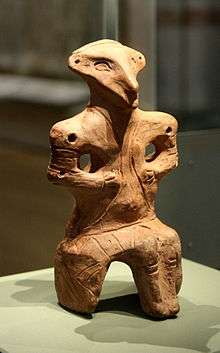


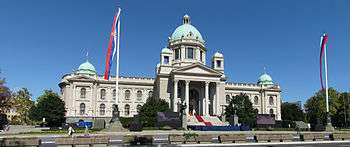


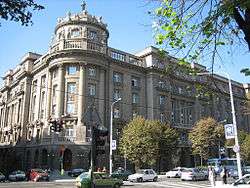
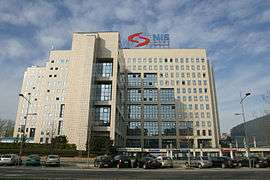
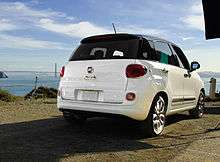


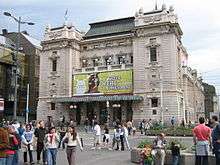
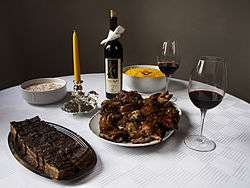

.svg.png)



